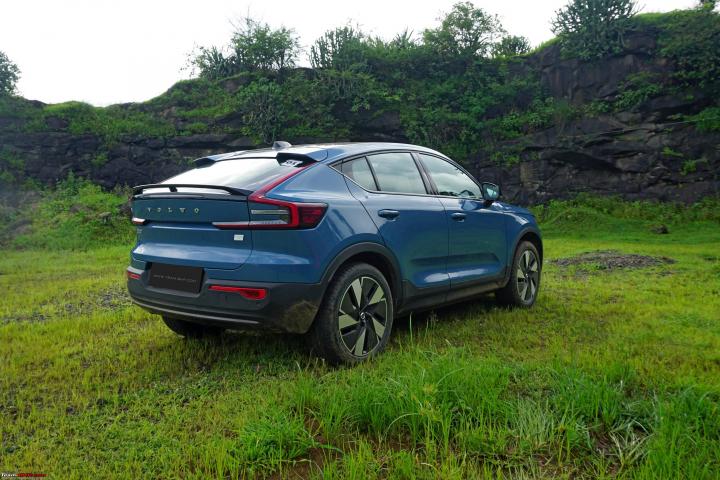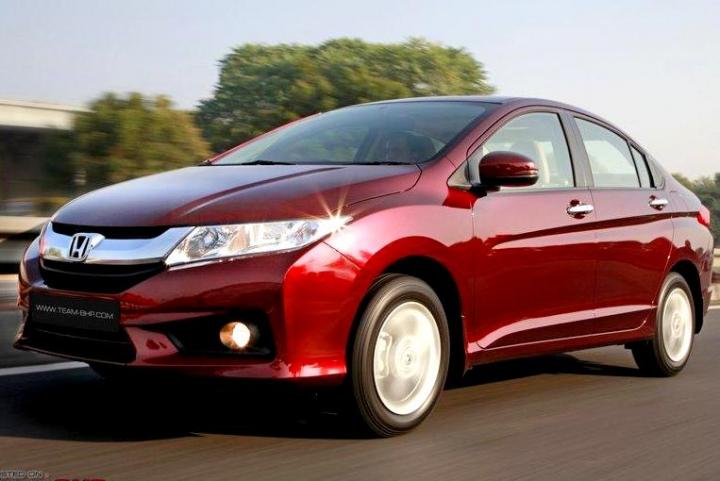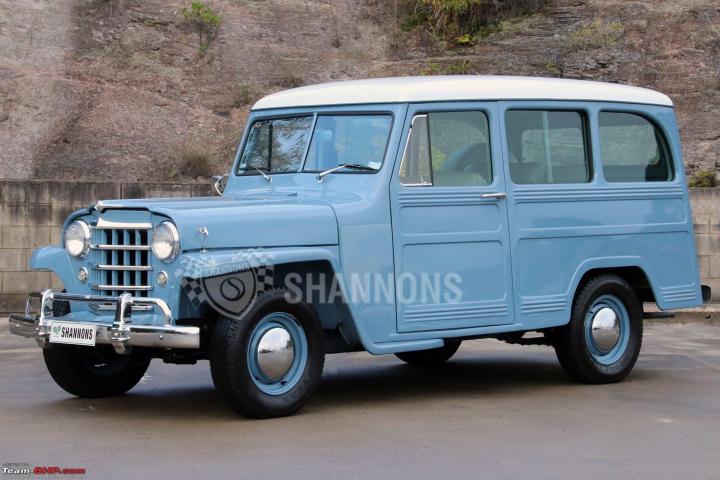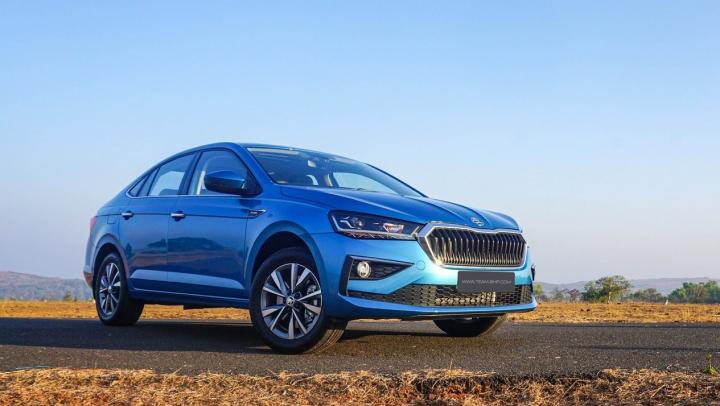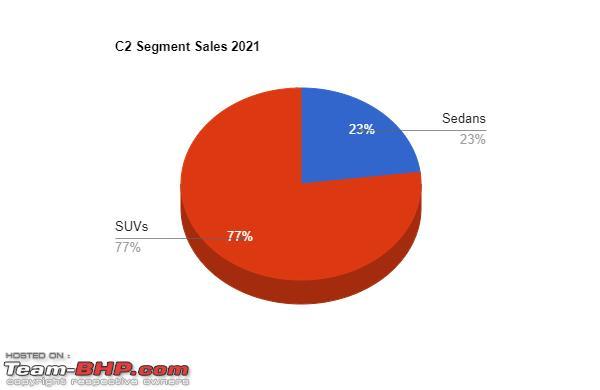News
What kind of car body style do people prefer and why
Some of the types that are available in India include hatchback, sedan, SUV, crossover, MPV/MUV, sportback, coupe, SUV coupe, convertible and pickup truck.
BHPian Aditya recently shared this with other enthusiasts.
Which one is your preferred body style and why?
Cars come in various body styles. Manufacturers are continuously looking to attract more customers by coming up with new body styles. While some would prefer an SUV for its butch looks, some prefer small hatchbacks and others want the exclusivity that a coupe or convertible gives. Here's a look at some of the body styles that cars available in India come in.
Hatchback
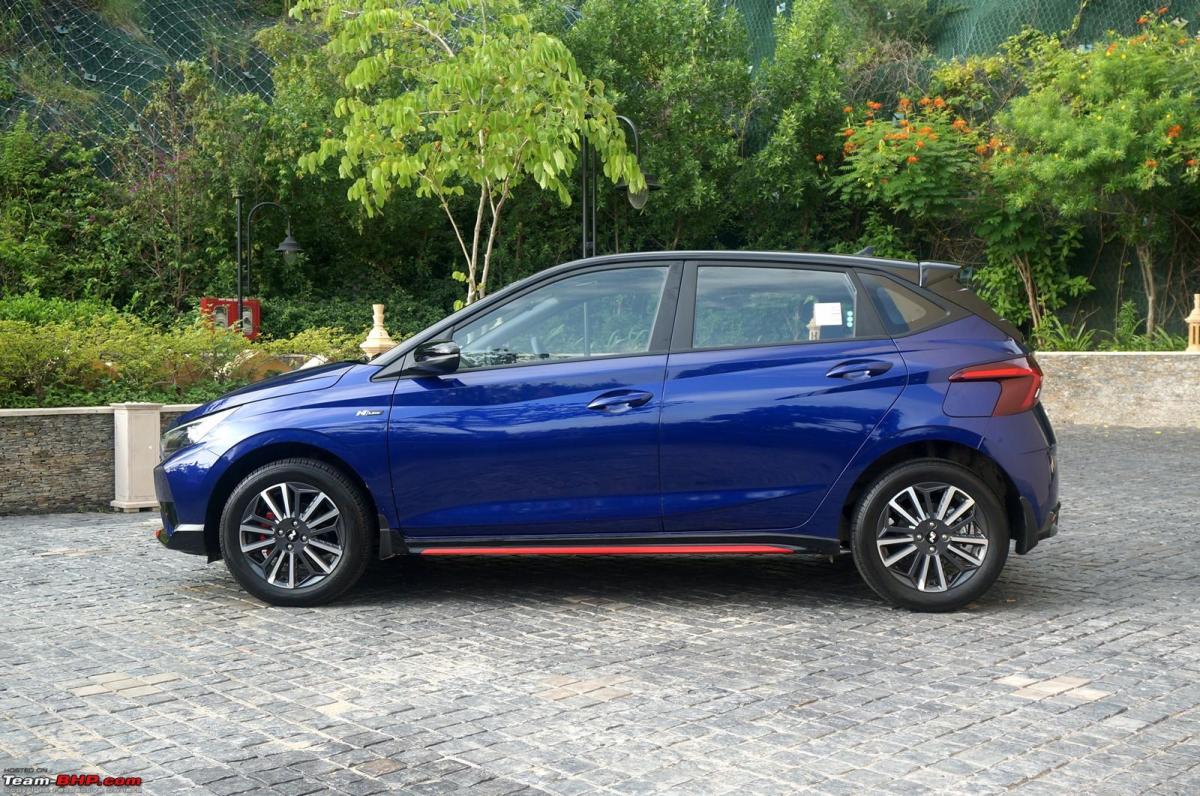
Some of the cheapest cars you can buy today are hatchbacks. They have a shorter wheelbase and are smaller in size than other types of cars. This means that they are easier to drive and park in crowded cities. If the rear seatbacks are folded, a hatchback can carry a good amount of cargo too.
Coming to the drawbacks, since the cars are small in size, interior space is limited, especially at the rear. Also, with all seats occupied, the boot is smaller in size compared to other cars. Apart from this, many hatchbacks have low roofs making ingress & egress difficult.
Sedan

Sedans, in general, have more cabin space than hatchbacks, making them more comfortable. They also have more boot space than hatchbacks and you can keep your luggage out of sight of others in the covered boot. Out on the open roads, these cars ride and handle well making them fun to drive.
However, there are some drawbacks to be considered as well. Because of the extra length (due to the boot), these cars are not as easy to drive and park in crowded areas. They have low roofs which hamper ingress & egress. Many sedans ride low and have poor ground clearance.
SUV
People love SUVs for their commanding driving positions. Their large size gives them an advantage on our roads where "might is right" and other road users tend to give you way. SUVs have a lot of space on the inside, and usually also get a third row of seats. Most have four-wheel drive and high ground clearance which makes them capable off-roaders. Their large wheels and chunky tyres help them tackle bad and broken roads with ease.
On the downside, their size makes SUVs cumbersome to use in the city and because of their high floor, ingress & egress are an issue, especially for the elderly. The cars are bulky and have lower fuel efficiency. They are not very good to drive on the road either and many of them have a bouncy ride.
Crossover

Crossovers are generally just hatchbacks with more ground clearance and plastic cladding and roof rails which lend them a rugged look. Those who find SUVs too large, but still want a rugged-looking car, will find them appealing. The increase in roof height also aids ingress & egress and the higher ground clearance helps them tackle high speed-breakers and broken roads with ease.
However, very few crossovers come with all-wheel drive (let alone four-wheel drive) and that means they may not be as capable as traditional SUVs off the road and not as good to drive on the road as sedans or hatchbacks due to their taller stance. Crossovers are usually 5-seaters and rarely get a 7-seater option which makes them less practical than SUVs.
MPV / MUV
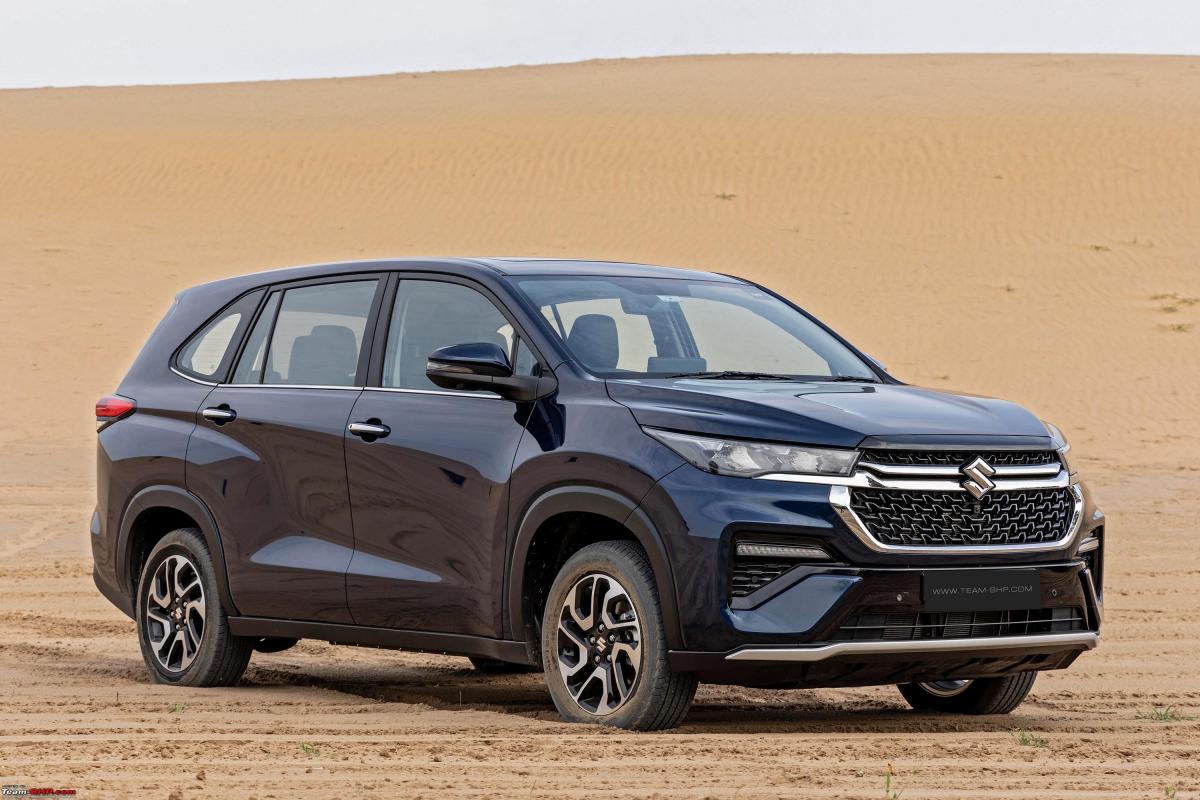
Recently, we had a thread on why MUVs / MPVs are the most competitive body style today. They come with higher seating which means a better view of the road and seating for 5-7 people. Their large size & butch styling along with commanding road presence is important in India where "might is right" on the road. They have large and powerful engines and high ground clearance which is necessary to deal with the large bumps and uneven & unpaved patches of road - a common problem in India.
However, like SUVs, the highway manners of these cars are also not as good as other body styles. Besides, many of them have a utilitarian image which may not go down well with urban buyers. Again, due to their large size, driving and parking in crowded cities will be a problem.
Sportback
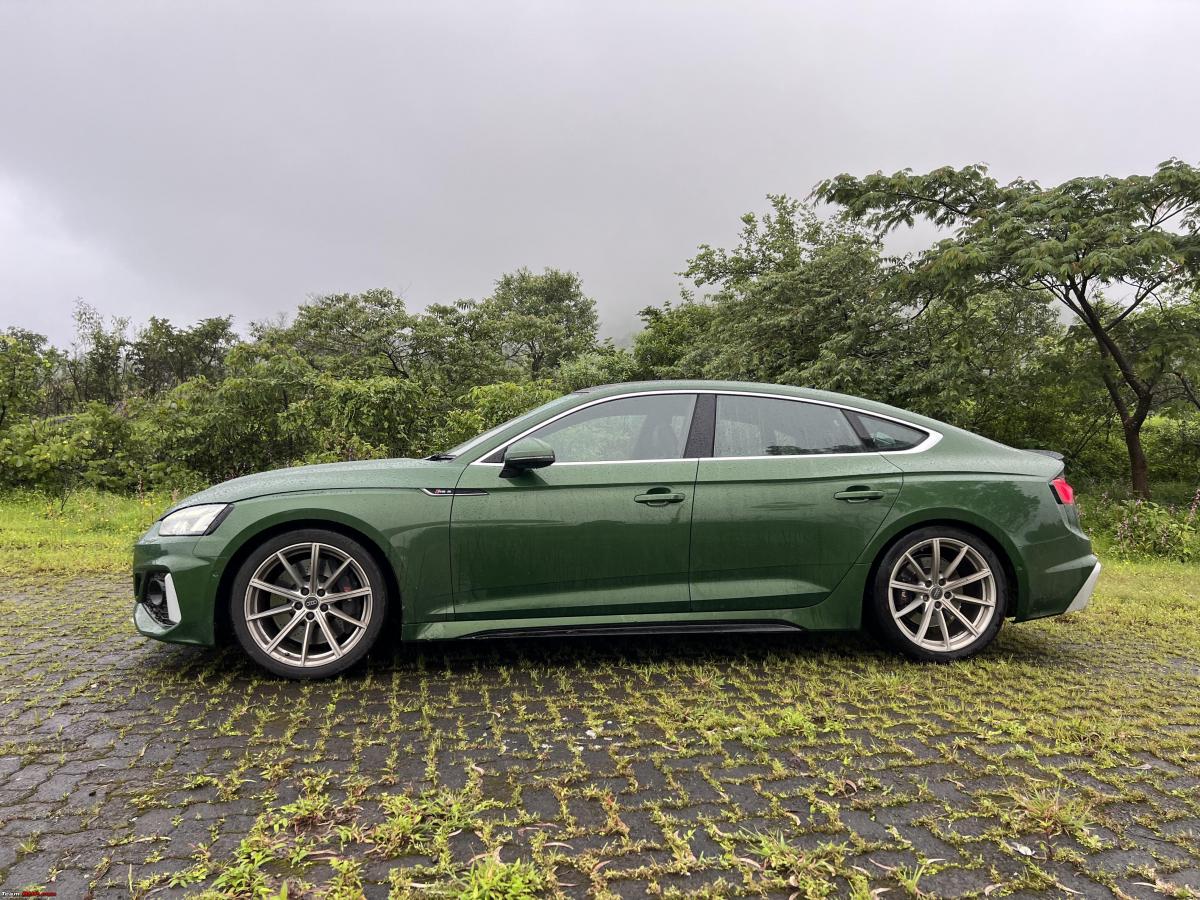
A sportback is a sedan with a sloping rear end to give it a sleek and sporty look. Such cars are rare in India and appeal to those wanting some exclusivity. These cars have a liftgate rather than a boot lid. This gives one a large boot opening.
On the downside, the sloping roof restricts headroom for rear seat passengers. Low-placed seats can make ingress & egress difficult too.
Coupe

Coupes are two-door cars with a low roof. They look sporty and usually feature powerful engines. They are more driver-focused. They bring exclusivity and desirability.
On the downside, coupes are expensive and low on practicality. Low seating means ingress & egress is not easy. Some come with rear seats but the rear headroom is compromised. Coupes also have low ground clearance which means the driver has to be careful while negotiating speed breakers and potholes.
SUV Coupe

BMW first came out with this new body style with the X6, combining the high ground clearance of an SUV and the sporty looks of a coupe. Very soon other players like Mercedes-Benz, Audi and Volvo introduced similar cars. SUV Coupes have seating for four and good luggage space.
Like regular coupes, they are expensive and the rear headroom is compromised thanks to their sloping roof line. Their styling can divide opinions too. Rear visibility is poor as well.
Convertible

One of the coolest body styles out there. Convertibles are exclusive and very desirable. With very few of them on our roads, you easily stand out. The biggest plus point of a convertible is the wind in your hair feeling.
However, the cars are expensive and are generally heavier than coupes thanks to the roof mechanism and they also need extra strengthening for their chassis. Even with the modifications, many convertibles are not as sporty to drive as their coupe siblings. Convertibles can't be used regularly in dusty, hot or rainy conditions. Besides, most convertibles are suitable for two occupants rather than four.
Pickup Truck
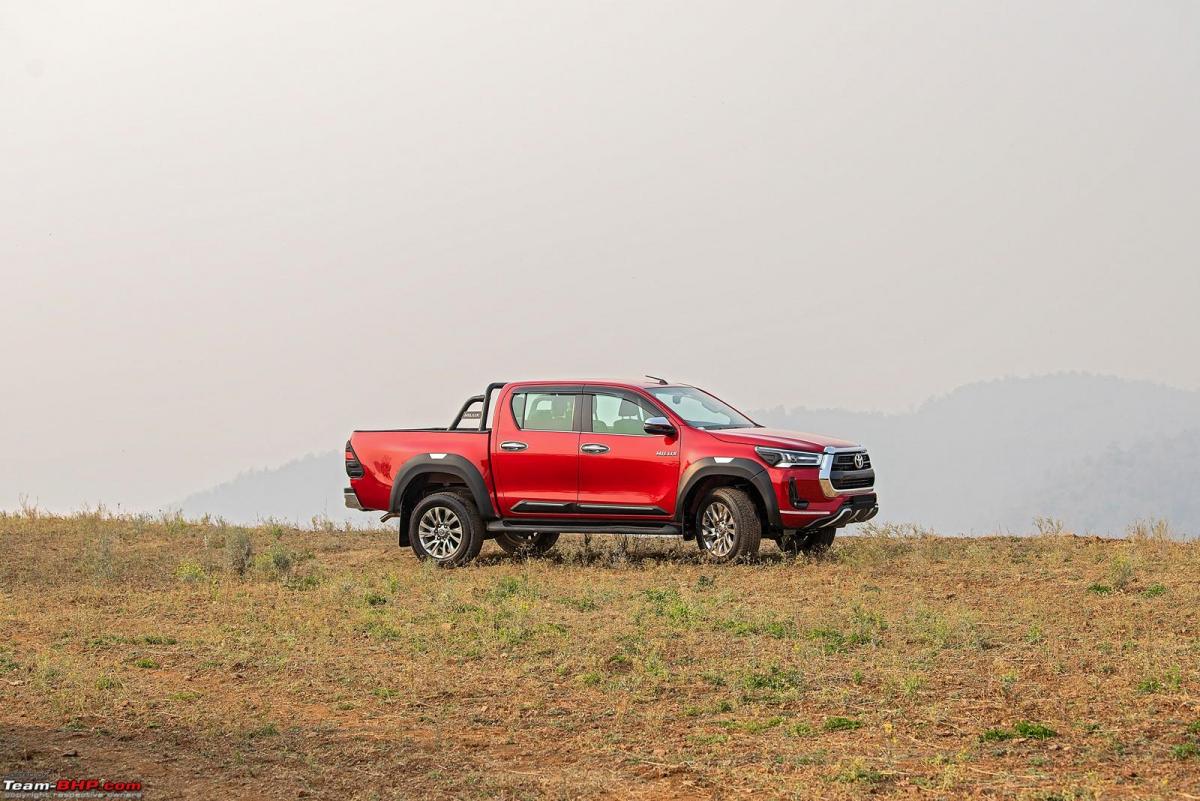
Pickup trucks are popular in countries like the US and Australia where they are used as workhorses. Some of them have great off-road capability as well. They have seating for four and a large loading bay that can hold more cargo than any other car.
Just like MPVs, pickup trucks suffer from the utilitarian image. They are also too big for Indian cities and parking a pickup truck can be very difficult. Additionally, if the loading bay does not have a cover, the cargo in it is at risk of being stolen.
Here's what GTO had to say about the matter:
My picks:
- Sedans, especially fast sedans. I love European sedans (Virtus, Octavia, 5-Series, M340i, S-Class)
- SUVs: Big & tough ones like the Thar, Scorpio-N, Safari, Endeavour are really my style. Great looks + practicality.
- Crossovers: We have such great crossovers in the market today! Among the affordable ones, I love the Kia Seltos & Nexon EV.
- Coupe: Will definitely own a Mustang, 911 or F-Car one day.
Not my scene:
- MPV / MUV could never be my primary car due to the "van" styling & image. I am a sucker for vanity.
- SUV Coupe is just a way-too-confused & awkward bodystyle to my eyes.
- Convertible isn't my scene (unless it's a 4x4). I'd rather own a Cayman over a Boxster. There isn't a single sportscar I'd buy in convertible guise.
- Pickup Truck: In the USA, yes, because of models like the F150 in luxury editions. In India, it's a pointless bodystyle, although very stylish.
Here's what BHPian MotorDev had to say about the matter:
Voted for Sedan.
I still favour them over any crossover or SUV because of the generous boot space they provide and their appealing aesthetics. Plus, they handle quite nicely as well.
Here's what BHPian vattyboy had to say about the matter:
Voted for SUV Coupé
Looks Delicious
Here's what BHPian CArspeed had to say about the matter:
It’s Sedan for me for the following reasons:
- Comfortable ride
- Flickable and agile
- That proper car-like classic looks
The SUV may be good for the ingress and egress but my dad and other elders prefer my Altis to Compass since according to them they don’t feel tired in Altis even after a long ride plus their feet don’t swell in Altis since they are able to stretch their legs without bending it too much.
Check out BHPian comments for more insights and information.
News
Will traditional sedans ever make a comeback in India?
Considering the substantial investments in highway projects and the development of new expressways, the quality of roads is progressively improving. In light of these advancements, do you foresee any possibility that, within the next five years, the era of sedans might experience a resurgence?
BHPian im_chandan recently shared this with other enthusiasts.
In Indian auto industry, it's evident that SUVs currently dominate market with a substantial 53% share, and this dominance is continually expanding. On the flip side, sedan sales are consistently declining, with only a few models remaining on the market. This decline is causing a noticeable reduction in the driving pleasure that sedans traditionally offer.
Yesterday, within my office campus, there was a display for the Skoda Slavia. My friend and I decided to explore the Slavia, even though he had already booked the new facelifted Nexon's top model. The salesman suggested that if my friend test-drove the Slavia that day, he might consider canceling his Nexon booking.
Now, turning to the broader question: considering the substantial investments in highway projects and the development of new expressways, the quality of roads is progressively improving. In light of these advancements, do you foresee any possibility that, within the next five years, the era of sedans might experience a resurgence?
Here's what GTO had to say on the matter:
Nope. And this isn't just for India, the sedan bodystyle is suffering a global decline. So much so that Ford abandoned it in USA.
For any bodystyle to make a "comeback", it has to offer significant advantages. But sedans lose out to crossovers in terms of GC, seating position and (arguably) styling. Because it's a dying segment, even the product choices get slimmer. Corolla, Civic, Accord, Teana, Elantra etc. are all dead.
While the Rs. 15 - 50 lakh sedan segment is either declining or dead, there are two exceptions:
- Entry level segment which is very price sensitive. Sedans will continue to sell here (I'm looking at you, Dzire). Plus, there is enormous demand here from Uber & Ola.
- Unbelievably, the high-end segment. Audi, BMW, Mercedes are all happily selling very healthy sedan volumes. Example, the S-Class is still the S-Class and the GLS isn't even close to it in luxury or opulence. The 3-Series is still the car of choice for enthusiasts.
Here's what BHPian CrazY_dRiVer had to say on the matter:
Also to add - sedans also take up significantly more real estate, causing parking challenges in apartments and city areas.
Height is less of a concern for most people than length.
Here's what BHPian dr.AD had to say on the matter:
I do not think the trend has to do anything with the road quality. For example, as GTO said in his reply, even in the USA, where the roads are excellent and sedan is never a problem from road quality point of view, the sedans are on a sharp decline. Further, even in India, many of the people who are buying these so called baby SUVs or crossovers usually just use those in city (office commutes or mall visits on weekends) and their decision to buy that vehicle is not because of highway qualities across India.
I think it is more of a style statement and a fashion to buy a SUV or a crossover. Something that has got an aspirational value today that the mainstream sedans lost.
Talking about road qualities, yes I agree with you that highway infrastructure is developing fast in India. Myself and many of my friends in my driving circle have done plenty of sedan driving all across India and none of us think there is much of an issue. We love driving sedans on Indian highways. But we are a minority. The general people do not look at these road surfaces to decide their vehicle purchases. That is decided by what is the current fashion, and that is SUVs and crossovers, not sedans.
The high-end sedans are still selling well (maybe even selling more than ever before), because they still have that aspirational value!
I think the mainstream sedans (Civics, Corollas etc) have lost that aspirational value globally. And that is the main reason for this trend. This aspirational value is very subjective and often driven by marketing campaigns, trends and peer pressure too.
And that is why I am hesitant to comment on the future. Who knows, if some smart OEM launches a beautiful mass-market sedan at affordable price and markets it well, and purposefully creates an aspirational value for that sedan, it may sell well and the sedans can come back! Fashion has a funny habit of repeating the trends after a few decades.
I would not be surprised if say over next 10 years, people just get bored of the SUVs and crossovers, and then some new sedan suddenly offers a breath of fresh air, and the sedan trend comes back. Hard to predict the future.
Here's what BHPian Shreyans_Jain had to say on the matter:
I believe there is always going to be a market for sedans. They may not be the dominant body style going forward, but plenty of people appreciate the low slung three box design. Just something organically appealing about it. It is timeless.
One must understand that automakers have deliberately favoured the crossovers over sedans, not updating sedans enough with time. It’s a strategy to get you spend more for a smaller product. Relevant and competent sedans like new Verna and Virtus have brought love back to what was a dying segment. It is up to manufacturers to provide an up to date and genuinely competent product. Honda City type laid back approach will only result in long term decline.
Here's what BHPian Kosfactor had to say on the matter:
I told a friend of mine a few years ago to pick up a sedan instead of a crossover because it's a visibly larger vehicle for the same price - Size Matters. Between a Sub4M crossover and a Sedan , I recommend the sedan.
However given how Rolls Royce had to make an SUV, there is no stopping this trend now. If anyone has been to Mysuru for Dasara , every vehicle with Sunroof had someone through the roof , looking happily at all the festivities and lighting all over the city, I have to admit it can only be enjoyed topless.
At one point we were counting the number of people who were through the 'roof' there was one car that had 6 kids! Winner. By the way they extended Dasara festivities to one more week, so don't miss it, drive down and enjoy it.
I think making SUVs allow the OEMs to go easy on driving dynamics, the expectations are already set , same goes for fuel efficiency etc, they spend less to make the vehicle , you spend more to run it but everyone is happy in the end.
Here's what BHPian bhodrolok had to say on the matter:
I maybe a dinosaur but even the most dynamically sorted SUVs are just not fun to drive as sedans; they are also unnecessarily bulky, heavy and generally ugly.
I don't think sedans will make a comeback as in take over the SUVs but I really hope that they continue to exist in a significant number for those like me to continue to drive them.
Read BHPian comments for more insights and information.
News
Luxury car buying dilemma: Torn between the Audi A4 & BMW 2 Series GC
The Beemer looks too flamboyant for my liking and the rear just reminds me of a Verna BUT the frameless windows have my heart.
BHPian kal-el recently shared this with other enthusiasts.
Hello BHPians, this albeit my first post doesn't feel like it as I have spent countless hours on the forum enjoying these threads and having countless conversations with myself . Be it GTO's Thar or Joshmachine's Audi A4, it's like reading a novel, but about cars! Anyway, that brings me to my dilemma right now.
I'll be 25 next month, currently pursuing my MBA in Mumbai. We are a family of three- me, mom and dad. Right now, we own a 2011 Honda City V which has run close to 90K in 12 years. My parents don't drive and they rarely took the city out hence the reason for not crossing 1 lakh kms yet. Ever since I got my license, I have been enjoying it thoroughly but we all feel it's time for an upgrade. Our budget is 53 Lakhs (stretched). I am a sedan guy and a petrolhead through and through. This car would be driven by me solely in the city mostly but random short outings will pop up given the choices shortlisted below. The usage won't be a lot, maybe 400 kms a month.
Requirements:
Performance
Comfort
Cars rejected:
Octavia- In a perfect world, I'd have an Octavia standing in the parking lot last month, but sadly its discontinued.
Superb- It felt too long for city use. Also discontinued.
Tiguan- Mom found the rear seat comfort lacking over bad roads, suspension too stiff.
Koadiaq- This was perfect be it features or comfort, but the performance and 7 seater long SUV just didn't fit our city use.
Compass- Dad loved this but no petrol and maneuverability was a pain.
A class Limousine- Knees up sitting position at the back.
GLA- Petrol felt underpowered and diesel was out of budget.
Cars not considered:
Tucson- Didn't feel right plonking 40 L on a Hyundai plus the SUV stance and the looks were a bit too much for our liking.
War of segments:
I know I know comparing the A4 to the 2-series is blasphemy. I have been an Audi fanatic since a kid (my scaled grey R8 will vouch for that). And since this is our first entry to the luxury car segment, we wanted to do it right. I knew going to BMW meant performance, while Mercedes meant premium and to me, Audi does a bit of both and more whilst being understated and elegant. So I didn't bother with BMW or MB and drove straight to Audi for A4. In my mind, I get performance from the A4 and parents get a good rear seat comfort. But fate had other plans, more on that later.
Audi A4
Right off the bat, me and mom were drooling over how classy it looked and the interiors made me like it even more. It felt premium, a bit old school and understated. The ride quality was what blew me away. The suspension is soft and it felt like a magical carpet over bumps, so poised so plush I was sold then and there. It had a smaller sunroof and the design is elegant but not a standout in a crowd although we didn't mind this much. Parents were satisfied with the rear seat comfort too and the boot space was decent as well. Add to that the SA gave us such a good deal it was hard not to book it right then and there. Test drove the Q3 too and while the ride wasn't as plush the interiors felt new and the seating position was good however sedan took precedence in this comparison.

BMW 2 Series Gran Coupe:
Now this is where the confusion began. My dad is a sucker for surveying a lot before choosing anything be it a house or a mere belt. He wanted to try BMW and Mercedes but I informed him the competition aka the 3 Series and C class were way out of budget and the only ones in our budget are from a segment below and might feel a bit cramped. Regardless he insisted and that's how we fell in love with the 2 series. BMW fans would argue it's not a proper Beemer with FWD but as someone who has been used to FWD cars all my life, I quite liked it. The BMW blew me away with the handling dynamics, sure the ride wasn't as plush as the A4 and road noise crept in a bit but that was minimal and could live with. The main thing was rear seat comfort which is surprising. So my dad(5'6) and mom(5'1) sat perfectly in the backseat and my dad who hadn't been too vocal about the A4 had loads to say about the 2 series. They found the 2 series more comfortable in the back compared to the A4. Yes even I was in disbelief. T he thing id, the seating position is perfect in the Beemer while the seating position is very low in the A4, so much so my mom's feet were dangling in the car. So comfort wise my parents found the 2 series way better and dad was blown away by the wow factor it offered- the aggressive stance, the frameless doors, the gesture control, the interior felt newer and the panaromic sunroof as well. The price offered lesser than the A4 Technology(top trim) albeit just a lakh. Now here is the dilemma.
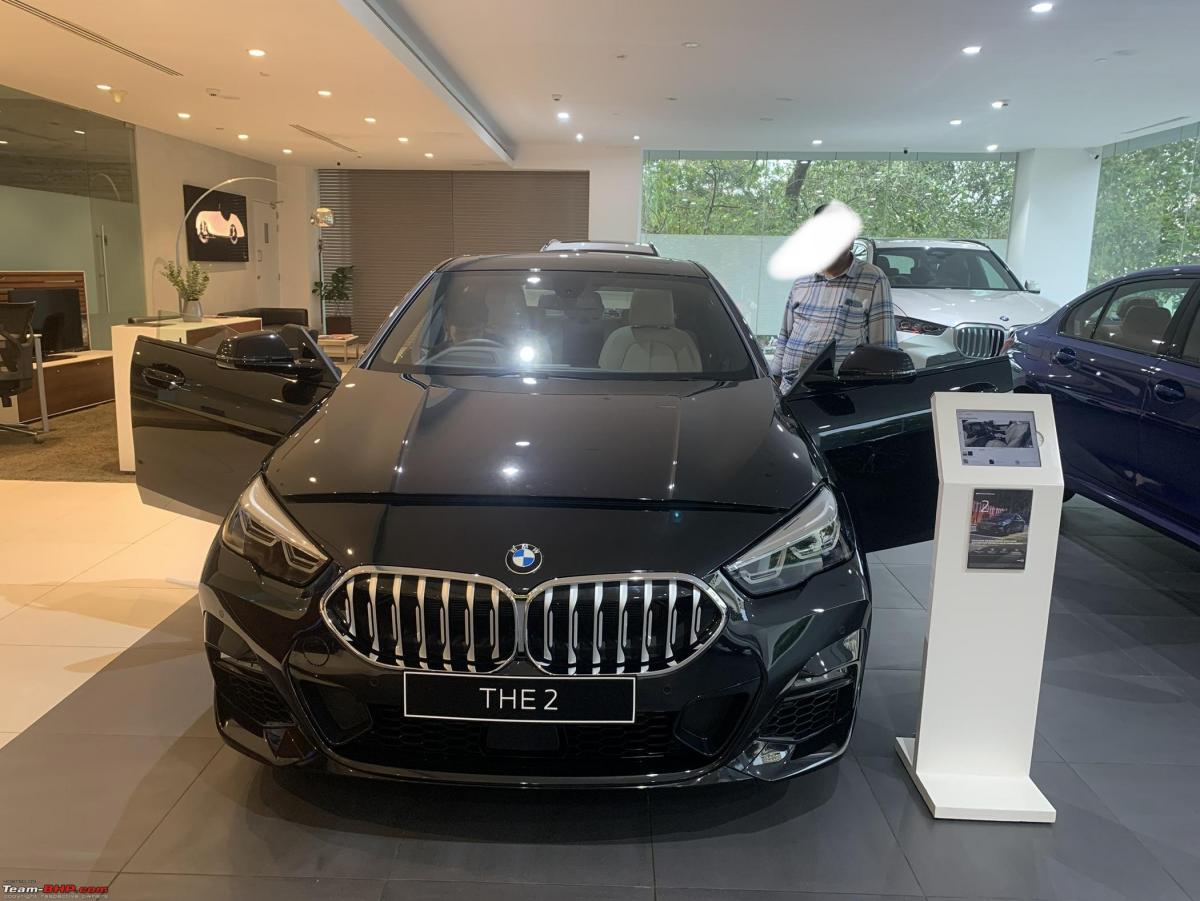
Ranbir- I quite love the A4 for its understated and elegant looks and the interior seems classic, the plush ride quality is just amazing and it looks like a proper sedan with a usable boot. My mom loves its looks and wants to buy it for that alone but says seating position is best in 2 series. My dad is just fine with the A4.
Ranveer- The Beemer looks too flamboyant for my liking and the rear just reminds me of a Verna BUT the frameless windows have my heart uff. It looks like a cramped sedan and arguably so, as the name suggests coupe. But I am blown away by its handling and though it lacks 40 nm of torque and plush ride quality compared to A4, its very comfortable as approved by my parents. i also love the panoramic sunroof coupled with the nicely laid out premium interior with wireless Apple CarPlay. My dad loves the Beemer so much so he took a picture with frameless doors. My mom likes it as well and found the ride comfortable and not at all stiff.
Hence quite the dilemma. We are going for a longer test drive tomorrow with both the cars back to back so will add more information about it tomorrow.The car will be mostly used by me(85%) and my parents will be chauffeured if they have to go somewhere which would be very rare. There's more chances of us going out to dinners and long drives together where dad will be in the front passenger seat. Also dad says we will keep the car for 5 years and maybe upgrade again. So I look to you, esteemed BHP members to remove my bias and point me in the right direction. I have some experience I want to highlight about the individual showrooms I visited but this has gone long enough, a different post maybe.
Here's what GTO had to say on the matter:
Hahaha! My Dad was the same (God bless his soul). To walk with him into an exhibition meant to spend time at each & every stall. But his curiosity also led us to the house / building we currently live in (story for another day).
With respect to your car dilemma, all I can tell you is, spending anything over 30-lakhs for a car is driven by the heart over the head. If you & your folks love the 2-Series, then that's the car for you. I would personally pick the A4, but hey, different choices & varying tastes is what makes this world a better place.
I do have one suggestion. With an open mind, please do test-drive the Ioniq 5 as well. It's a game-changer EV = fast, spacious, comfortable, good range, stunning looks and technologically very advanced. Whether you buy it or not isn't important. One TD will change your perspective about EVs.
Happy shopping, buddy!
Here's what BHPian PaddleShifter had to say on the matter:
Common logic would say:
- A4 vs 2 series- get the A4
- A4 vs any other BMW- get the BMW
I think you should go for the BMW because:
- You found it to be better performing compared to A4.
- Comfort: Though A4 should have scored well here but the subjective feeling for your parents was better for the BMW. Moreover, your parents will only find BMW even better as they age (compared to the lower seating of A4).
I see that the BMW excelled in both the areas. So better to go for the BMW. Size or segment does not matter to you anyway and you are simply looking for the better car as per your post.
Regardless, do compare the comfort on a slightly rougher road and speed breakers during your subsequent test drive(s).
Here's what BHPian Tutenkhamen had to say on the matter:
Good dilemma indeed.
I was in similar situation not very long ago.
What helped me out of it was to focus on top 2 or 3 things important to me, and rank the options. And then play a knock out match between the options.
For me, Good performance, Reasonably good comfort in the back seat and Wow factor (opulence?) came out on top.
Finally, went with heart. Financials just worked as a cherry on top.
These are not, and should be not; head decisions
You do you OP. Take both cars out on a drive on your favourite roads back to back (preferably within the same hour so the memories and ‘feel’ stays fresh).
Here's what BHPian manson had to say on the matter:
A peformance oriented car won't be as comfortable, and a comfortable car won't enjoy being pushed. The A4 is really comfortable and has lovely grunt but loses out in the handling due to its suspension set-up. The 2 GC on the other hand has relatively better handling but loses out to the A4 in space and ride quality. Seats are a personal choice but your family clearly prefers the ones in the BMW.
Advantage A4:
- Relatively better space
- Lovely ride quality, the suspension is perfect for Indian road condition
- Higher GC
- Adequate boot space for a holiday
- Built to a higher standard with better materials
Advantage 2 GC:
- Better dynamics, More fun to drive
- Snazzy exterior has a lot more occasion over the A4 (my wife said the 3 series is so ordinary in comparison)
- Seats better suited for your family
I'd normally recommend getting the A4 between the two (brought one home 2 years ago and loving it), especially if you are going to be spending more time cruising on highways. But since your family's heart is set on the 2 GC you must only get that and considering you're only 25 you have plenty of time to make understated and practical choices for the rest of your life.
Check out BHPian comments for more insights and information.
News
Looking for a used fun-to-drive car under 7 lakh, preferably a sedan
The 4th-gen Honda City i-VTEC is the top contender but finding a good example is a difficult task.
BHPian Tanmay_868 recently shared this with other enthusiasts.
Introduction
My name is Tanmay Jain. I am a 2nd year MBBS student. We are a family of 6 members. My brother is also pursuing MBBS while my dad is a doctor. My family loves driving. A true testament was provided by my grandfather when he said he used to drive his trucks personally to places like Assam, Gujarat from Delhi with just a conductor and himself regularly.
Thus being 19 years old I myself have gained enough experience in driving due to driving thousands of kms including peak city traffic jams which according to my dad is the real test to gauge one’s driving skill.
Our current garage includes
- MG Hector: bought in 2021
- Hyundai Grand i10: bought in 2018
- MS Celerio: bought in 2016
We are currently looking to replace our Celerio which has run around 89k but has started developing some problems due to its age and rough usage by our drivers.
Requirements
- Looking majorly for a pre-owned car
- Budget- Restricted to 7 lakhs by parents. But I think with a little nudging from me and my brother it can be increased because they know we will always cross the limit which has been decided upon (I am sure you all also would have experienced this with your kids).
- Age- Not older than 2017
- Odo reading- <50k for 2017 models
- Usage- Will keep the car for 5-6 years
- The car would be used primarily for local errands and sometimes me and my brother would take it to college. Also, dad will primarily use the i10 but when another car is needed then this car will be used.
- Main requirement is Fun To Drive. We need a car that would give us Smiles per Mile.
- We don’t have any parking problems.
- We haven’t had a sedan till now, so the balance is implicitly tilted towards sedans. But any other body type can also be had.
Shortlist
- Honda City i-VTEC 4th gen facelift - As all of you would already have guessed, the City is the top contender on our list. That i-VTEC is just a gem of an engine along with ample space it is just a perfect car. But finding a decent one will take time since currently all the ones listed on OLX are dealer cars and none is from a direct individual. This is the olx ad.
- Hyundai Verna 1.6 Petrol 5th gen - 2017 Verna with 1.6 VTVT engine is also nice but finding one <7 lakhs is quite difficult. We liked the overall quality of the car but till now haven’t test-driven the car.
- Volkswagen Vento TSI 1.2 AT - Came across a 2017 Vento posted by a dealer that has run 38k and can be had for 7 lakhs post negotiations. But have not seen it till now.
- Ford Ecosport facelift - Considered it briefly but not pursuing it further since didn’t like the hard clutch of the 1.0L Ecoboost variant of my uncle which we drove. OLX link 1, link 2
- 2017 Hyundai Tucson 2.0 - Came across this advertisement of Tucson. Car is being sold by the owner directly which he bought at a bank auction and now selling after using it for a couple of years.
- 2022 Rapid TSI
So members please help me in narrowing down my choices and do suggest the prices at which these cars should be bought. Out of the crop of N/A engines from various manufacturers (1.5 i-VTEC, 1.6 VTVT, 1.6 MPI) which would be the best. Suggestion for any other car which I may have left is also appreciated.
Thank you in advance.
Here's what GTO had to say about the matter:
7-lakhs is a very good budget for a used fun-to-drive car in Delhi… the largest car market by far and with the best prices in India.
Top choices would be the Rapid 1.0 TSI with its wild li'l motor, Polo & Vento. Next-in-line choices would be the XUV300 Turbo-Petrol & Duster 1.3L Turbo (for its 154 horses & brilliant ride quality). Last would be the 4th-gen Honda City 1.5L.
If you are open to spending slightly more money, take a test-drive of the Citroen C3 1.2L Turbo-Petrol. It's a pocket rocket that offers oodles of fun. Fast engine, slick gearbox, sorted suspension and brand new is brand new. The C3 Turbo boasts fantastic engineering under the skin.
Avoid the EcoSport, Abarth Punto etc. All long discontinued models with declining or poor support from their makers.
Here's what BHPian mura had to say about the matter:
i10 Nios Turbo. A remap away from 140bhp and is super easy to maintain and service. It might not be the last word in handling but it is huge fun around the city with just a tire upgrade. You can get an almost new 2022 model with less than 5k on the odo for your budget easily.
Here's what BHPian ByKaizen had to say about the matter:
If you are planning to consider hatchbacks/diesel, Swift diesel will be a great choice.
Pros:
- Engine, for sure will bring in smiles due to the enormous torque
- I could see around 20+ Swift diesel with your criteria around Delhi on OLX (2017+ <50k)
- Less maintenance
- Good resale.
- Well within your budget (4 to 6L)
- Fuel efficiency (Easily 15-20 kmpl)
Cons:
- Steering feedback, handling will not match the Germans
- One among the crowd, not unique
But with the budget of 7L, after buying there will be some room for mods which can be used to upgrade wheels, tyres, suspension, audio, ECU remap* (*if you wish, but this is worth it)
Here's what BHPian IshaanIan had to say about the matter:
You can knock the Verna 1.6 petrol off of your list because while the chassis is fairly balanced since it’s derived from the Elantra, the motor won’t feel as strong as a Japanese NA or as powerful as a smaller but turbocharged German unit would overall it is a very weak motor best suited to automatic transmission and sedate usage.
With that out of the way, unfortunately, there isn’t too much choice in the sedan segment especially since they have been on the decline over the past decade. Try looking out for a 1.4 TSI manual Škoda Octavia. They didn’t sell many so finding one might be tough but it should fall in your budget and is leagues better than any Rapid/Vento would be.
Another interesting choice would be the Abarth Punto. Rides excellently over our roads that are filled with potholes and pulls strongly as well.
If you cannot find a good example of either the 1.4 Octavia or the Abarth Punto, you cannot go wrong with the Honda City.
Check out BHPian comments for more insights and information.
News
India's transition from sedans to hatchbacks to sedans to crossovers
The journey of Indian car preferences since 1957 is described with maybe many misses. With hatchbacks, mini-sedans (both due to affordability) and mini-SUV's ruling the sales charts, some more shifts in buyer preferences could be discernible in the coming years and decades.
BHPian anjanc_2007 recently shared this with other enthusiasts.
The car scenario in India is being discussed on this thread starting from the restricted or rather banned imports era of 1957. The Tariff Commission was constituted by the Ministry of Commerce and Industry, Govt of India, in March/ May 1952 and chaired by Mr M.D. Bhat to look into imported automobile custom duties and to discourage imports. A phased manufacturing programme was stressed to encourage automobile makers indigenize their products in a phased manner. The Commission's report was submitted the government in May 1953 to be made effective from three years later.
An excerpt from the Tariff Commission report of 1953:-
The Commission has recommended that future demand should be concentrated on these five firms, and the assembly operations of those without a manufacturing programme should cease within a period of three years.
In order to concentrate demand on the five firms with a manufacturing programme and to provide for the progressive manufacture of the types of vehicles required by the country, the Commission has suggested a plan of manufacture of various types by different firms and a programme of progressive manufacture of these types. Briefly the plan is as follows:-
(a) Hindustan Motors, Ltd., will manufacture a light car, a big car and a medium truck.
(b) Premier Automobiles, Ltd., will manufacture a big car and a medium truck.
(c) Automobile Products of India, Ltd., will manufacture a light car and a medium truck.
(d) Standard Motor Products of India, Ltd., will manufacture a medium car only.
(e) Ashok Motors, Ltd., will concentrate on a heavy truck and a baby car, if a suitable scheme is put forward by them.
The Commission does not consider that any of the five manufacturers is likely to make jeep-type vehicles. It has recommended that, for the present, the requirements of Jeeps, both Civil and Military, should be met by the existing assemblers of jeep-type vehicles.
Please just peruse how biased the report was in favour of Hindustan Motors.
Back to the topic, Indian car buyer’s preferences had been earlier dictated by a Hobson's choice during the licence raj era that was effective since 1957. We had only three sedans from Hindustan Motors, Premier Automobiles and Standard Motors, with Mahindras offering their Willys/Jeep UV and Station Wagon. The Willys Station Wagon was a SUV and also fitted the definition of a hatch perfectly.

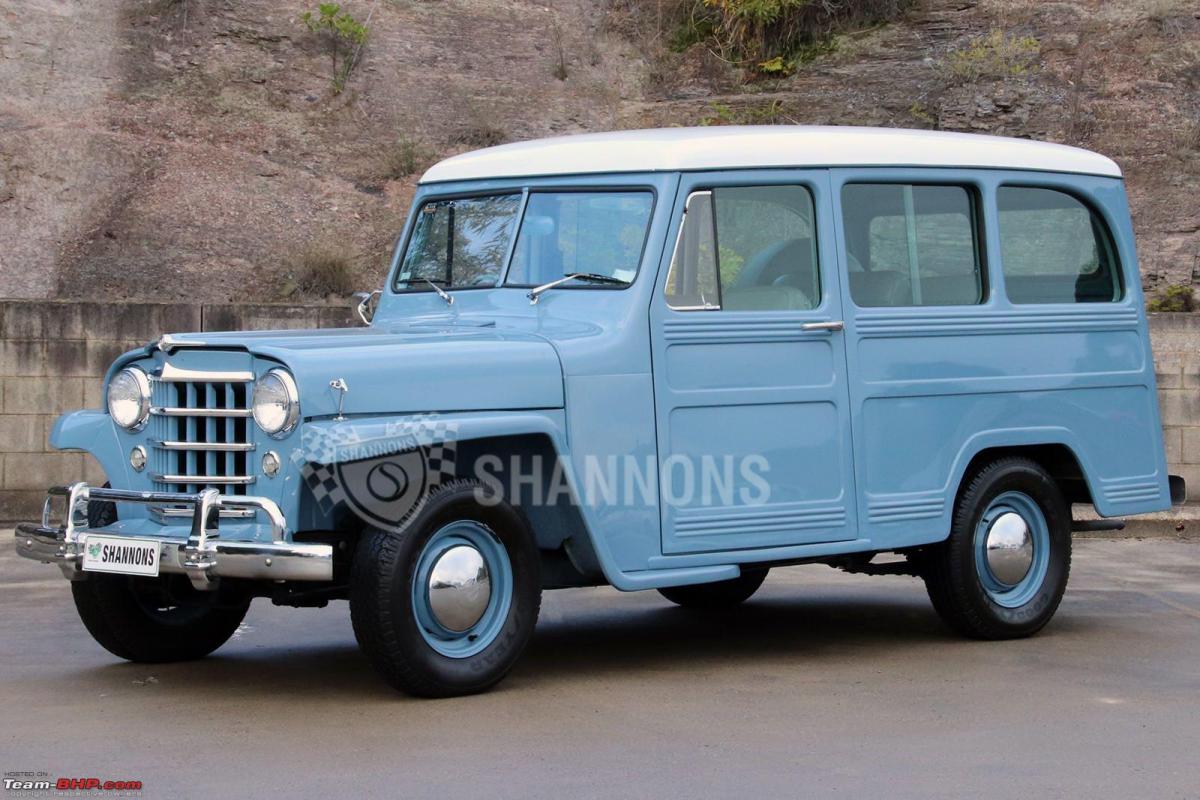

1951 Willys Station Wagon images courtesy Shannons Auctions
The liberal imports era commenced since the turn of the last millennium (20thcentury) through the 1950's. American made Station Wagons mostly had similar hatch configurations with the tailgates/ tail doors opening fully to allow access for loading goods. Americans used these for their weekend getaways and hence their market received such Station Wagons very well. These were sold in decent numbers in India too. The 1950’s were dominated by Chrysler Corporation badged Dodge, Plymouth and DeSoto station wagons here in India. During licence raj era, we had all the three car makers launching Station Wagons though these sold marginally. Though post-liberalisation, we saw many flops as far as station wagon sales were concerned viz. the Fiat Sienna Adventure, Opel Corsa Sail, Baleno Altura and the Indigo Marina to name some. Going by their fate, car makers of today are station wagon launch-phobic. The hatchbacks and SUV’s have now almost replaced station wagons in all sizes.
The three sedans offered by HM and Premier ruled our roads all through the late 1950's till the mid 1980's. Standard ceased manufacturing its Gazel (the last sedan model) by around 1976-77. HM and Premier faced headwinds, come entry of the tiny hatch from Maruti Udyog Ltd, the SS 80 in 1984 and later in 1986, the SB 308 apart from the Van/ Omni and Gypsy it offered. The SS 80, though does not fit the definition of a hatch as will be evident in the meaning below. Only its rear windscreen swung upwards denying full access to the main interior. Tata Nano will also fail to meet the hatchback segment requirements, going by the definition.
The hatch era had begun with the car sale figures to be soon cornered by the Maruti 800 (SS 80 and later SB 308). Sipani's Dolphin/Montana were also hatchbacks but the sales were insignificant. The early 1990's ushered in sedans from Maruti (1000/ Esteem) and soon after also from Daewoo, Ford, Opel (it was a larger hatchback though), Mercedes and Peugeot. During the turn of the millennium and during later years Honda, Toyota, Chevrolet, BMW and Audi, Renault (later Mahindra) joined with their launches of sedans and SUV’s/ MPV’s followed by others. Fiat tried to crack the hatch segment with its Uno and later with Palio, followed by Punto but these never really sold well. Fiat Sienna/ Linea and their Sienna Adventure were also non-starters. The Daewoo Matiz was well accepted but the company’s downfall sealed its fate.
Definition of a hatchback car:-
A hatchback is a car body configuration with a rear door that swings upward to provide access to the main interior of the car as a cargo area rather than just to a separated trunk. Hatchbacks may feature fold-down second-row seating, where the interior can be reconfigured to prioritize passenger or cargo volume.
Maruti continued to rule the hatch market with a slew of consecutive new launches starting mid-1993, with Zen followed by the Wagon-R , Alto/K-10, Ritz, Swift, A Star, new 800 and Celerio to crowd the B segment. Most of these were/are best sellers. The Esteem established Maruti’s foothold in the C segment. The Baleno sedan (old) was under-rated and a non-starter. Their SX-4 (now defunct) that came after the Baleno sedan and its replacement the Ciaz sold/ sell quite well. The Swift Dzire/ Tour was and is a best seller.
Hyundai came along in 1998 with its Santro followed by the i 10/ Grande, Eon, i 20/Asta and so on to also crowd the B-segment. Hyundai’s lower C segment offerings, Accent, Xcent, Aura have also been well received. They did well soon to emerge as India’s # 2 car maker. Its D segment launch, the Sonata failed to click though his car is among the Top 5 selling sedans in the US.
Tata Mobile, the pick-up launched by Tata (then TELCO) in 1989 was a springboard for their entry into the car segment. The Sierra and the Estate were launched soon after in the early 1990's. The Estate though a station wagon was also a large hatchback going by the definition. The Safari launch around 1996 showed their seriousness to stay in the car business. Tata Motors launched the Indica in 1999 and soon after the Indigo. These were discontinued after their model life was over. Their refreshed versions failed to click. Their Nano too never sold decently. Tata’s renaissance has come of age comprising SUV's, sedans and hatches launches during recent years that have made Tata the #2 or # 3 largest car maker (depends on their monthly sales) in India.
Overall since the post 1984 era, considering sales as the market barometer, hatchbacks have ruled in our markets. The lower C segment sedans have also dominated the scene post the Swift DZire launch, owing to affordability.
Thereafter, with the lower C-segment sedans and hatchbacks interchanging top places among themselves sales wise, the Hyundai Creta launch by mid-2015 was a game changer. It has ushered in a new dawn with the success of the mini-SUV's in a niche that was unexplored. The Ford EcoSport launch in mid-2013 though preceded the Creta launch. The EcoSport’s success showed auto makers that this segment is worth a try.
Mahindra was already into the MUV/SUV space achieving success by catering to its markets. They considered entering the mini SUV segment where the action was and filled voids since the past few years with their own launches. The KUV 100 flopped, while the TUV 300 has been kept afloat. The XUV 300 sells in decent numbers.
The mini- SUV's are getting wide attention and every manufacturer worth its salt is foraying into this segment. Indian, European and Far Eastern car makers have flooded the market with their new mini-SUV launches. Honda is also launching its Elevate, come early June 2023.
The upper C segment sedan sales are under stress owing to the preference of buyers for mini-SUV's as of now.
Even with EV's getting launched by many car makers, EV sales in mini SUV segment are likely to gain a foothold in the market. The hatch segment and possibly the lower C segment EV's will also be in demand owing to the price tags that suit a large number of buyers.
The journey of Indian car preferences since 1957 is described with maybe many misses. With hatchbacks, mini-sedans (both due to affordability) and mini-SUV's ruling the sales charts, some more shifts in buyer preferences could be discernible in the coming years and decades.
Here's what BHPian shancz had to say on the matter:
A very pleasant and fascinating read with morning tea
One thing is very clear is that the definition of "type" is very unclear, even today.
If the Willys Station Wagon was a hatchback and the SS80 wasn't then in today's world the S-Presso and Ignis are "SUV"s like the Creta and the Nexon. Not to forget that all of them are "hatchbacks"
The definition of the "hatchback" is sound but its our usage which tries to shoehorn it into a small family car frame which is at fault. Like we've done for "mileage" instead of average. But can't say the same for SUVs.
Read BHPian comments for more insights and information.
- Tags:
- Indian
- sedans
- hatchbacks
- crossovers
- SUV
News
Sedan under Rs 15 lakh as an upgrade from 2020 Maruti Ignis
I've shortlisted the Slavia, 5th-gen City and Ciaz but my wife is against all of these cars as she wants us to get an SUV.
BHPian TorqueSteer recently shared this with other enthusiasts.
Hey all!
Currently, I own a 2020 Ignis Zeta. Car has done around 8k kms only due to COVID and all but been my daily driver for the last 6 months as my office has reopened. Ignis is a pretty good city car. Nimble, fuel efficient and relatively peppy. But bumpy ride quality is becoming an issue for me, especially on city roads.
I got bit by the upgrade bug recently. Honestly, I got bored of Ignis especially since there is a Honda and Skoda showroom right next to my home and I've been in love with Slavia and City ever since. So I'm planning on an upgrade. My usage is daily 30 KMS home-office-home and once-a-quarter highway trips of about 300kms.
Requirements below
- I absolutely love sedans. That low seating makes me feel like I’m in a supercar
- Decently fuel efficient. Anything between 8 KMPL to 12 KMPL is fine with me. The more the better. (FYI, Ignis is giving me 14 KMPL in Pune traffic with 100% AC ON)
- Has to be under 15 lakhs
- Since my primary usage is in the city, has to be comfortable on bumpy roads
- Good quality and good-looking exteriors and interiors
Cars I’ve shortlisted:
Heart : Skoda Slavia Ambition MT
Why?
- Been in love with it since its launch. Especially the Red color.
- Loved the quality of interiors.
- Looks very premium for the price. I’m eyeing the Ambition variant and it is pretty well-equipped.
- Service centre is a couple of kms away from my home.
Why not?
- Stories of A.S.S. I’m looking for a painless ownership experience.
- Worried a little about fuel efficiency. Getting mixed reviews.
- Cost of spares.
- Wife wants an SUV.
Brain : Honda City V 5th Gen facelift MT
Why?
- City is my childhood dream car.
- Extremely reliable
- Fuel efficient
- Easy to maintain and cheaper ownership compared to Skoda (I’m guessing)
- Service centre is a couple of kms away from my home.
Why not?
- Honda’s approach towards the Indian market points towards exit
- Tyres look puny and spoil the entire car’s character. Will need an upgrade immediately.
- Dashboard looks good but the infotainment looks like an afterthought.
- Ground clearance issues as there are a lot of speed breakers in my locality.
- Wife wants an SUV.
Practical : Maruti Ciaz Alpha MT / AT
Why?
- Most value for money. A top-end mid-size sedan under 14 lakhs that too an AT.
- Maruti’s reliability
- Fuel efficient
- Service centre is right beside my home
Why not?
- Dated interiors. Looks pretty basic.
- Same Maruti again. Doesn’t feel different than my Ignis. Hate the steering wheel. Chances are high of getting bored.
- Wife wants an SUV.
Wife’s options :
- Maruti Grand Vitara : Maruti’s reliability and peace of mind but my budget allows me to get a Delta which I think isn’t VFM at all. I loved the Zeta but it’s a little stretch. Power figures are bad. I feel it’s too big for regular city use.
- Skoda Kushaq: Ambition MT is on the 15 lakh mark. But I’ve heard that the fuel efficiency is less than Slavia. A little concerned about the potential ownership experience and along with spares & service costs.
All your inputs are highly appreciated.
Here's what GTO had to say about the matter:
You want a fast Skoda.
Wife wants an SUV / Crossover.
Just get the Kushaq. It is so much fun to drive! And has practical aspects too. You'll enjoy it. Also consider the VW Taigun.
Here's what BHPian RavSam had to say about the matter:
Wow! I too am an owner of a 2020 Ignis Zeta and my dream car since childhood is a Honda City.
There are a lot many options today and I can afford more expensive ones including some SUVs but then if I were able to buy a Honda City, and I always dreamt of buying it, I would go ahead and buy it. Especially since it's a car with not many flaws.
There are many dreams and if one is able to fulfil one of them then why not?
P.S. Also, I would just not sell away the Ignis too soon. At 8k odd kilometers it has barely run in. My Ignis now, after 10k plus kms drives like a charm and buttery smooth and keeps up with speed with even mightier cars. Would at least drive it till 25k.
All the best!
Here's what BHPian bijims had to say about the matter:
Considering the fact that you love sedans and hoping that you would be able to convince your wife, the best options in the sedan segment around 15 lakhs on-road would be Honda City V MT or VX MT, Skoda Slavia Ambition MT or Hyundai Verna SX 1.5 VTVT. Of the three, the City and Verna come with 1.5 L N.A. Petrol engines which produce 119 bhp and 113 bhp of power and 145 nm and 144 nm of torque respectively, the Slavia comes with a 1.0 L turbo petrol (TSI)producing 114 bhp of power and 178 nm of torque.
The City is a dependable car with all-round qualities which has made it a best seller in the sedan, the Slavia is the more fun of the lot, but maintenance costs of Skoda have historically been higher compared to its Japanese and Korean counterparts. The all-new Verna is a good car in its own right with modern styling and amenities.
As regards features and price, all are well equipped and priced closely and you wouldn't go wrong with any of these cars, but In my opinion, if your heart yearns for a Skoda, you should definitely go for it!
Check out BHPian comments for more insights and information.
- Tags:
- Indian
- Maruti Ignis
- sedans
- SUVs
News
2023 Verna vs 5th-gen City vs Virtus: Which sedan would you buy?
The new Verna is funky & all-rounded in nature, the Honda City remains a car you just can't go wrong with and the Virtus / Slavia are a whole lot of fun.
BHPian Omkar recently shared this with other enthusiasts.
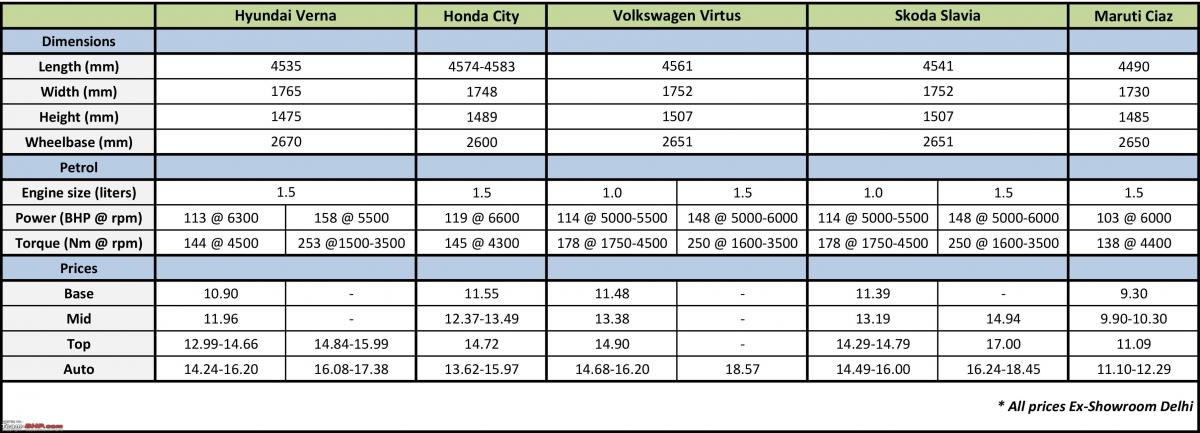
Hyundai Verna

What you'll like:
- An all-rounder sedan that ticks all the right boxes
- Well-positioned overall package. Priced competitively against rivals
- User-friendly interiors with good cabin space
- 158 BHP, 1.5L turbo-petrol engine is the most powerful in the segment. Gets a quick DCT too
- Comfortable, neutral suspension setup riding on 205/55 R16 tyres
- Long list of features includes LED auto headlamps, ventilated seats, electric driver’s seat, sunroof, wireless charging, smart trunk, rear sunshade & more
- Safety equipment includes level 2 ADAS tech, 6 airbags, ESC, 3-point seatbelts for all, rear disc brakes, front & rear parking sensors etc.
- Hyundai's wide service network & up to 7-years extended warranty
What you won't:
- Futuristic styling will polarise opinions. Many BHPians think the design is too edgy & unusual
- Better quality plastics should’ve been used in a car that costs 20+ lakh on-road
- No diesel engine on offer. The outgoing Verna was the last diesel sedan in the segment
- Turbo-petrols are very sensitive to driving style. FE will drop drastically when you drive hard
- Dual-clutch ATs have a history of poor reliability in India. Note: Verna with 1.5L NA CVT is available
- Back seat is more suitable for 2 healthy adults and a child. Not 3 healthy adults
- Not as much fun-to-drive as the VW Virtus & Skoda Slavia
- Missing features like a 360-degree camera, wireless Android Auto & Apple CarPlay, auto wipers and foldable rear seat (a must in sedans IMHO)
Honda City
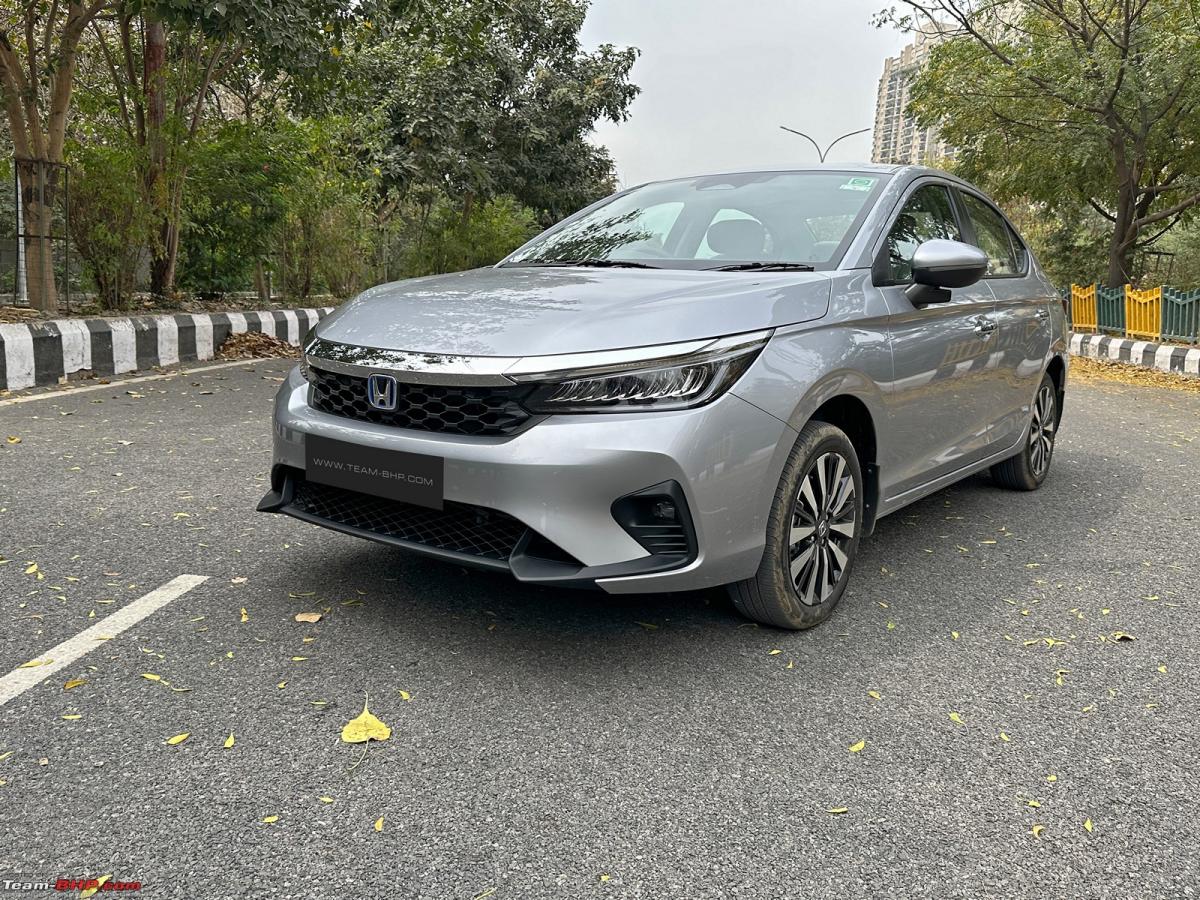
Volkswagen Virtus

What you'll like:
- A ‘complete’ car that just might bring some love back to sedans
- Classy exterior & interior styling, along with solid build quality
- Cabin has good legroom on offer, supportive seats, perfect ergonomics & enough storage
- 521-litre boot is quite spacious
- 148 BHP engine makes the Virtus among the most fun-to-drive sedans in the segment
- Sporty 1.0L & 1.5L turbo-petrols are mated to smooth transmissions
- Sorted suspension offers a balanced ride & handling package
- Safety features include 6 airbags, ESC, 3-point seatbelts for all, electronic differential lock, brake disc wiping, multi-collision brake and more
- Features like active cylinder tech, ventilated seats, sunroof, wireless Android Auto and CarPlay, auto headlamps & wipers etc.
- 6-year extended warranty & 4-year all-inclusive service packages available
What you won't:
- No 1.5L diesel is a major disadvantage in a world where petrol costs over 100 bucks/litre
- DQ200 DSG transmission has a history of poor reliability & breakdowns in India
- No MT option available with the 1.5L petrol. The Slavia offers this combination
- Backseat better for 2 healthy adults and a child, rather than 3 adults
- Lovely 1.5L TSI is only available on the top variant. Should have been there in the mid-trim too like the Slavia
- Interior quality doesn’t feel up to old school VW standards. Body-coloured interior highlights are polarising too
- Missing some features such as a subwoofer, driving modes (sport), 360-degree camera & electric driver's seat adjustment
- Turbo-petrols are very sensitive to driving style. FE will drop drastically when you drive hard
- VW’s after-sales service can be a hit or miss. The brand’s long-term reliability can be patchy as well
- Slavia's 'clever' touches are missing = no spot on top of the dashboard to place a deity, no smartphone holders on the front seatbacks, no ticket clip on the windshield, no elastic band in the door pad to keep items in place, or even something as simple as the small reflective tapes on the doors
Skoda Slavia
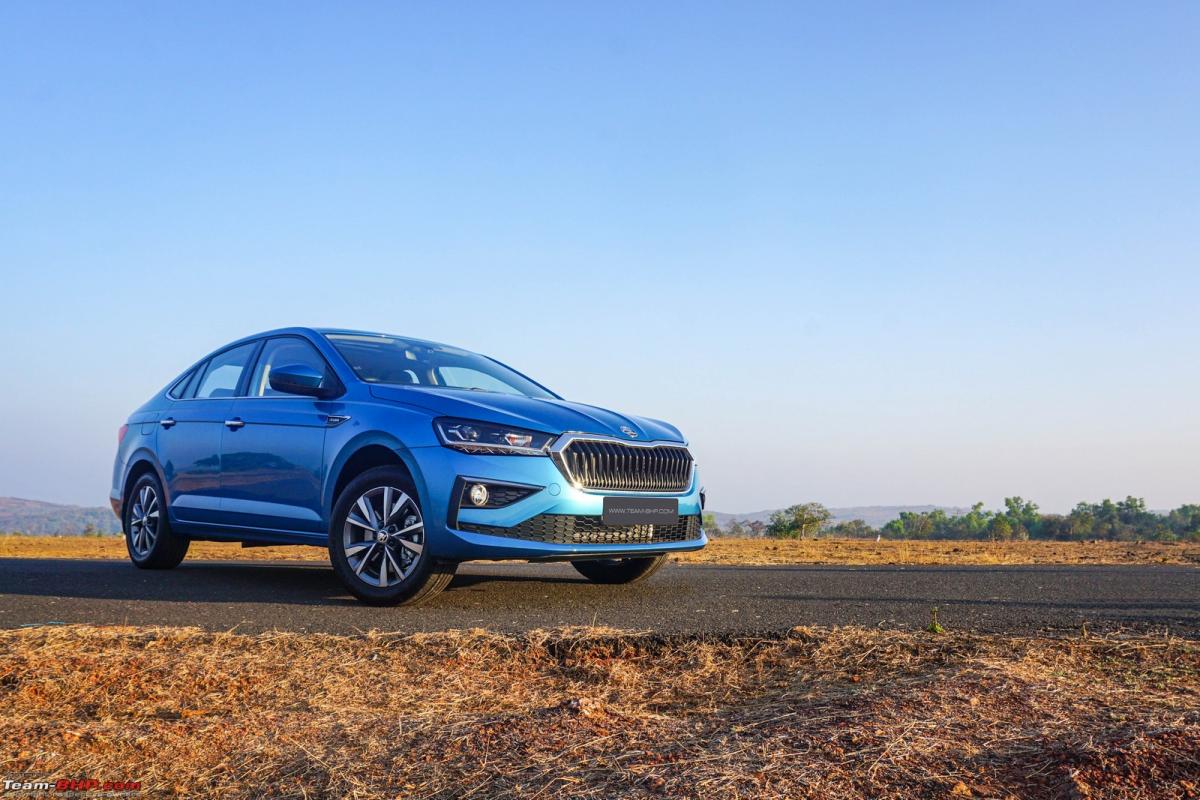
Maruti Ciaz
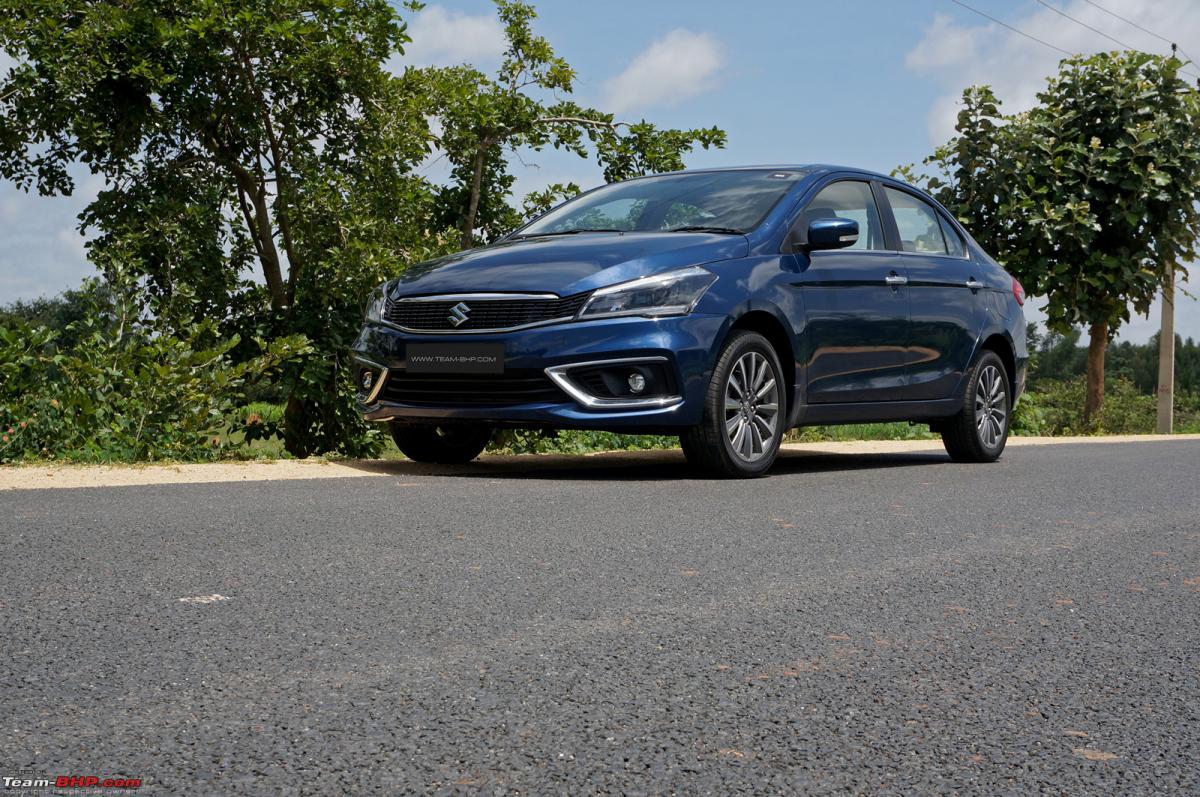
What you'll like:
- Clean and conventional styling that will please the masses
- Value-for-money pricing that undercuts almost all rivals
- Spacious cabin with lots of practical features. The rear legroom is particularly impressive
- 1.5L petrol motor is smooth and refined
- Soft, compliant ride quality. A suspension that's tuned for comfort
- Big 510 litre boot will swallow your airport & holiday luggage
- Maruti’s excellent after-sales service, wide dealer network & fuss-free ownership experience
- Equipment such as the automatic LED projector headlamps, DRLs, 7" touchscreen ICE, rear sunshade, cruise control, telematics system etc.
What you won't:
- 1.5L petrol is rather mediocre. City & Verna petrol engines are much superior
- 4-speed Automatic gearbox feels old & outdated
- Uninvolving to drive. Enthusiasts look elsewhere
- Average under-thigh support of the low rear seat. Also, limited rear headroom for 6 footers
- Light build & ordinary interior quality. The game has moved on with newer competitors
- Missing features by today's standards like a sunroof, driver assistance system, sunroof, side and curtain airbags, 360-degree camera, etc.
Here's what GTO had to say on the matter:
Other than the antique Ciaz, all C2-segment sedans are very strong offerings. The new Verna is funky & all-rounded in nature, the Honda City remains a car you just can't go wrong with and the Virtus / Slavia are a whole lot of fun.
My tastes are now inclined toward European cars, hence I will pick a VW Virtus or Skoda Slavia. For that awesome 1.5L DSG, driving pleasure & 5-star safety.
Here's what BHPian Aditya had to say on the matter:
Skoda Slavia 1.5L turbo + MT. It's got looks, space, pace and safety. I don't want anything to do with DSGs. So the VW Virtus is out of the reckoning.
I don't like the Honda City's high-speed driving dynamics and I am not sure of the Hyundai Verna's looks. The Ciaz is too old to be considered.
Here's what BHPian Shreyans_Jain had to say on the matter:
The decade + old and obsolete Ciaz does not belong on this list. We’ve had 3 generations of City and Maruti has been pushing its same sedan.
Between the City, Verna and Virtus/Slavia, the least attractive option remains the City. It’s a spacious and reliable car, but in this company, that’s about it. Build, engines, suspensions, ride and handling are all wanting. The hybrid model fixes a lot of the shortcomings but it is obnoxiously overpriced. At 25 odd lakhs, cars like Hector, XUV700 and Harrier also make a strong case for themselves. They have made ADAS standard, but I see it more as a gimmick, not something very useful or deal-making.
Tough call between Verna and Virtus/Slavia. All three are very competent all-rounders, guess it boils down to personal preferences. My pick will be Virtus, simply on account of the clean, timeless styling. The car is just gorgeous. Also happens to be the safest mass-market car you can buy in India.
Here's what BHPian SNA411 had to say on the matter:
Voted Ciaz, because of its immense VFM proposition.
The base Sigma variant itself has everything that you need, at a price point of 10.21 Lakhs on-road.
AC, Power Steering, 4 power windows, factory-fitted music system with Bluetooth, remote lock-unlock, rear centre armrest etc.
Good reliability, a good service centre network, and great fuel economy are added advantages.
Just spend 30k on alloys, and you're set.
Although if I had to buy a car for 11L on-road, my money would probably go to either a Brezza or a Bolero Neo.
Check out BHPian comments for more insights and information.
News
2021 sales analysis: Phenomenal year for SUVs when compared to sedans
In both C1 & C2 segments, SUVs have had a much larger market share than sedans.
BHPian MADisMynAMe recently shared this with other enthusiasts.
The Fall of Sedans
C1 Segment Sales Analysis 2021
In 2021, the compact sedan segment (sub-4m segment) had a total combined sales of 2,13,905 units. The Dzire was the only car to cross the 10k monthly sales mark (barely) whereas the Amaze and Aura were close to 5k sales a month and the Tigor close to 2.5k. The Aspire, on the other hand, could not reach 500 units a month and left India along with Ford selling a minuscule 1502 units last year.
Compact SUVs on the other hand had a phenomenal 2021 in sales. The total combined year sales racked up almost to 6 lakh units, at 5,77,788 units (excluding the Thar because we are comparing only Pseudo SUVs). Cars like the Brezza, Nexon, Venue and Sonet were constantly between the 5k-10k mark, sometimes even crossing it. The Ecosport, Magnite, Kiger, XUV3OO and Urban Cruiser (why so long a name!) were always below 5k. The WR-V on the other hand struggled to reach the 2k mark in the first half, and could not cross the 500 mark in the second half!
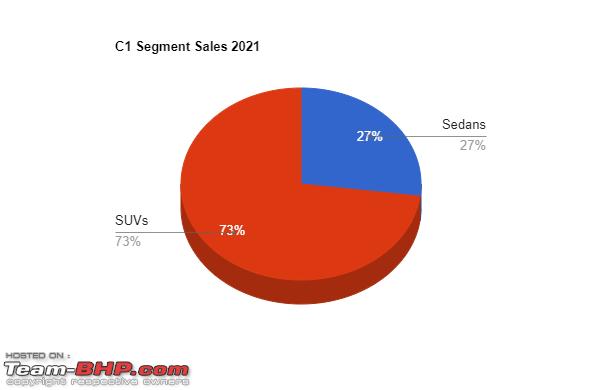
All in all, the sedans segment took only 27% of the total sales of the C1 segment with the rest 73% with the SUVs.
C2 Segment Sales Analysis 2021
In 2021, the mid-size sedan segment had a total combined sales of 82,191 units. The City was the leader, with monthly sales below 7.5k, followed by the Verna. The Ciaz was struggling between the 750-3k unit mark and the Rapid could not cross the 1k mark. The Vento could not reach the 500 mark. The Yaris, on the other hand, was struggling to reach the 1k mark for each month in the first half, but then sales decreased to less than 10 units a month in the second half. Sales were so bad that the Yaris had to be discontinued.
SUVs on the other hand had a combined sales of 2,74,588 units (sub 4.5m SUVs, since cars like the Harrier were too huge and the 7-seaters were in another segment altogether). The Creta was mostly selling above 10k a month, followed by the Seltos, which ranged between 7.5k-10.5k units monthly. The S-Cross, Kushaq and Taigun would sell below 3k units monthly, whereas the Duster and Kicks would struggle to reach 500 units monthly.

Again, the market share of the sedans in the C2 segment was 23% whereas the SUVs took a share of 77%.
Check out BHPian comments for more insights and information.
News
Buying a dream sports sedan: Have I missed the boat?
The world is going electric, and fast! As a self-proclaimed, born petrol-head and keen driver for the past four decades, I could not believe I did not prioritize buying a fun-to-drive car for myself.
BHPian Viju recently shared this with other enthusiasts.
So I am 40, happily married, with 2 beautiful kids. I bought the perfect vehicle for my family (a spacious 3 row SUV) just over a year ago, and it is really nice to drive - AWD, comfy, luxurious etc.
But this past Saturday night, I woke up from a terrible nightmare - all sweaty, scared and feeling really awful. I have had a few 'regular' cars until now, in multiple body styles - hatchback, wagon, minivan, and now, SUV.
But all of them have been Front Wheel Drive, at best, with part-time AWD. And the past three cars I have owned have been automatics - two of them were dreadful CVTs no less! I have never owned a car with more than 4 cylinders, or over 250 bhp.
The world is going electric, and fast! As a self-proclaimed, born petrol-head and keen driver for the past four decades, I could not believe I did not prioritize buying a fun-to-drive car for myself.
Sipping my coffee, looking at the sun rising over the Tokyo skyline, I wondered if I made a terrible mistake, and forever lost my chance of buying a 'real' fun-to-drive car brand new from the showroom - which in my definition goes like this:
- Low-lung, sporty, sedan - must be beautiful
- 6 cylinders
- Front engine
- Rear wheel drive
- 300 bhp+
- 450 N-m+
- 4 doors, 5 seats
- 6 speed Manual Transmission
- RHD
Before my family could even get out of their beds, I frantically started searching online for such a car.
After an hour or so, I could find only one car which met all criteria. But I am pretty sure the date of expiry on this five year old bottle of wine is not much longer (I cannot buy my next car before 2026 at least, unless I win the lotto, which is impossible, as I don't buy it!).

Pic courtesy: bcimracing
Am I missing something? Is this it? Did I miss my chance of ever owning my dream car, brand new from the factory?
And no, you cannot convince me to go for the ZF Auto, no matter how good it is! (Believe me I know it is good, ZF is my employer no less).
Help?
Here's what BHPian DicKy had to say on the matter:
Erm... I won't vouch for the beauty part. But all these do scream at that quintessential sports sedan. The M3. Though am not sure of the manual transmission part in Japan. A decade ago, maybe could point towards Nissan or Toyota for the above mentioned criteria (except adjust power for the 2000s)
The Alfa Romeo while beautiful to look and hear, from the reviews it seems Italian enough. One look at that B pillar positioning, you know this won't be as well thought out as the Germans.
Assuming you would be coming back to India for good, why not use TR when you plan to come back to import a car that would not just be a keeper, but a heirloom too. ( I sound stupid saying that)
Here's what BHPian GForceEnjoyer had to say on the matter:
I'd say no, the dream sports sedan isn't dead for now. With a manual though? That is debatable.
The Cadillac CT-5 V Blackwing is currently my definition of a sports sedan (not luxury sports sedan, under which I'd classify cars like the M5). A purely rear-wheel drive sedan with a manual transmission paired to a 6.2 Litre 670 horsepower supercharged V8 engine is literally what dreams are made of!
But Japan unfortunately does not get it, so your best bet would indeed be an Alfa Romeo Giulia or an M3 (less the manual unfortunately). Truth be told, manuals in this segment are really rare nowadays. So unless you're happy with an automatic transmission, the options become rather limited. A BMW 540i came to mind too, but then again no manual available unfortunately. I can only wish you good luck with your search.
Read BHPian comments for more insights and information.
- Tags:
- Indian
- Alfa Romeo
- sedans
- sportscars
News
How the sub-4m segment has shaped India's automotive landscape
Maruti, Hyundai, and Tata together have dominated the sub-4m segment with nearly 80% market share over the last decade.
BHPian pqr recently shared this with other enthusiasts.
Genesis and the journey of sub-4-meter passenger vehicles in India
"On cars, I propose to reduce the excise duty to 16 per cent from 24 per cent, but only for small cars. A small car, for this purpose, will mean a car of length not exceeding 4,000 mm and with an engine capacity not exceeding 1,500 cc for diesel cars and not exceeding 1,200 cc for petrol cars. I am confident that industry will seize the opportunity to make India a hub for the manufacture of small and fuel-efficient cars."
- 2006-07 Union budget speech (point no. 137), Finance Minister, Government of India
Genesis
That was the policy decision taken by the union government in 2006, which fostered long-term development and sales of small cars in the Indian market thereafter.
Sub-4-meter passenger vehicle market share

On an average, 73% of cars sold in the Indian market have a length of less than 4 meter since policy implementation in 2006.
In the pre-policy days, there was rapid growth of affordable sedans (Ford Ikon, Hyundai Accent, and Tata Indigo) introduced by manufacturers, and overall sub-4-m car sales were on the downfall. Post policy enactment in 2006, hatchbacks witnessed faster growth than any other category, as per the policy design.
However, in the previous decade, manufacturers learnt the art of packaging sedans and crossovers to fit into policy-layed constraints and fueled the journey further. The share of this vehicle category reached the highest level of 79% in 2018. In recent times, demand for entry-level hatchbacks and sub-4m sedans has declined, leading to a low share of 73% in 2022. Moreover, a new breed of crossovers with a wide price spectrum in recent times has substituted demand for sedans and hatchbacks in the sub-4-meter category.
2017 - Opportunity to change the status quo

At the time of GST implementation in 2017, the government had a chance to rationalise the very idea, which appears to be based on some arbitrary assumptions. However, nothing was reformed, thus paving the path for the status quo, forever.
Product Innovation
Hatchbacks sold in India were already shorter than 4 m, so they became more affordable because of lower excise duty. In some cases manufacturers just have to shrink engine size (1200cc for petrol and 1500cc for diesel).

The Indian market was never ready for hatchback products longer than 4m, as the majority tended to look forward to sedans in that case, for a status symbol (emotional need) in those days. Chevrolet's attempt with the 4.3m long and ambitiously priced SRV bombed in the Indian market.
Since 2006, manufacturers in India have become innovative to fit sedans and crossovers (with SUV silhouette) body styles within the constraints laid down by the small car policy to fulfil the emotional needs of customers.
Sub 4m sedan
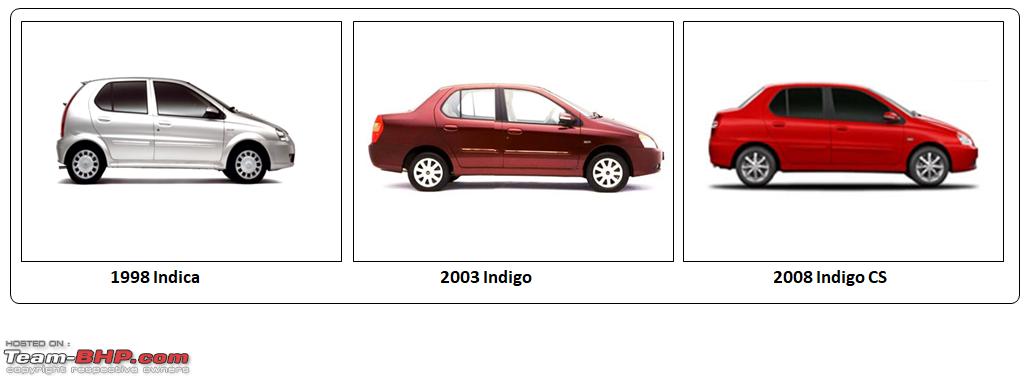
The very first non-hatchback product to take advantage of the lower excise duty was the Tata Indigo CS. Basically, it was a truncated boot version of Indigo already on sale. The Indigo was derived from the Indica hatchback by the integration of the boot to make a 3-box structure. The hatchback to sedan development concept was seen earlier in India by FIAT (Palio hatchback/Siena sedan) and Opel (Corsa sail hatchback/Corsa sedan).
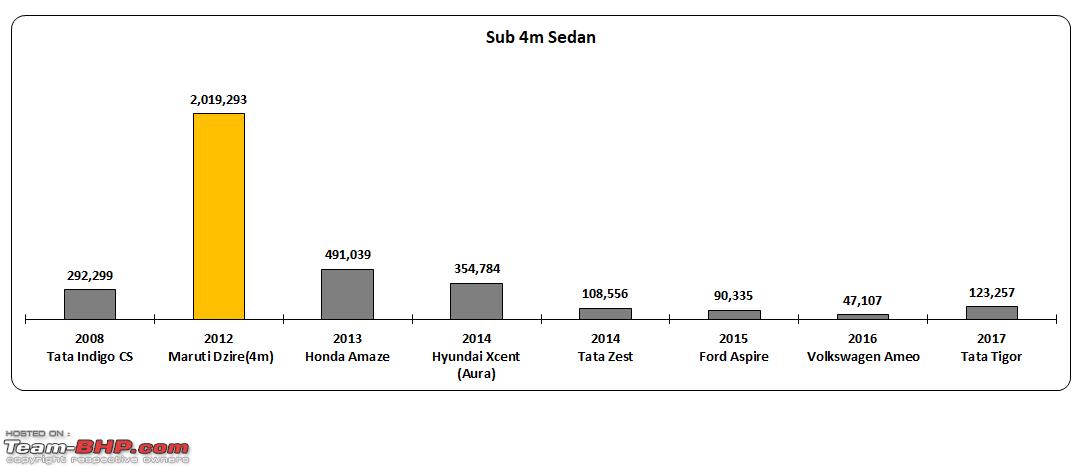
Looking at the success of this approach, every other manufacturer since then has used their hatchback as a donor platform (Maruti Swift-Dzire, Honda Brio-Amaze, Hundai Grand i10-Xcent, Tata Bolt-Zest, Ford Figo-Aspire, Volkswagen Polo-Ameo and Tata Tiago-Tigor) and integrated boot along with complete re-engineering of the body behind the B-pillar. Maruti turned out to be the most successful player in this segment, and Volkswagen the least.
Sub 4m SUV/Crossover (Monocoque chassis)
To gain a better understanding of the strategic marketing concept behind the sub-4m crossover, here is a quick apples-to-apples comparison of sub-4m hatchback and sub-4m crossover products from the same stable.
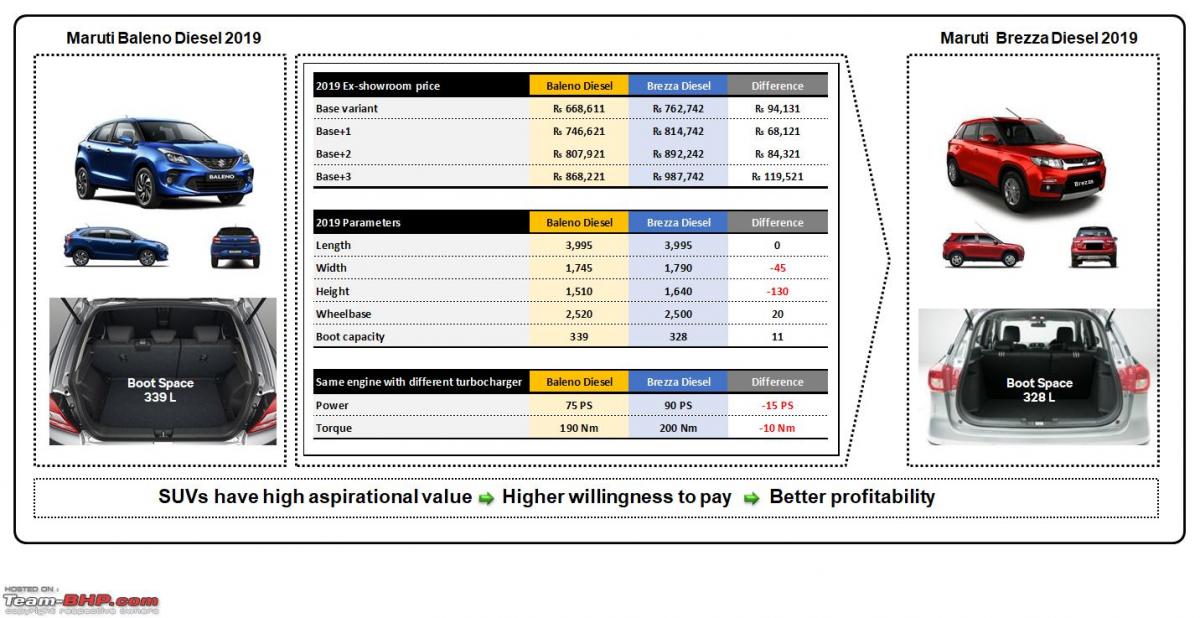
- Sub 4m hatchbacks and SUVs offer similar functional benefits i.e. similar in-cabin and boot space
- SUVs do offer better ground clearance, and that's an additional functional benefit as road infrastructure is still not very good in India
- SUVs offer a commanding seating position (emotional benefit)
- SUVs have a much higher perceived aspirational value as lifestyle products (emotional benefit) than hatchbacks
- This leads to a higher customer’s willingness to pay
- Manufacturers have better pricing opportunities and may lead to better profitability
Product development strategy
Manufacturers in this category have tried different product development strategy.

Approach 1: Rebadged CKD product
The first sub-4-meter crossover was the Rio (rebadged Chinese Zotye T200) from Premier Auto Limited (PAL), launched in 2009. It was assembled at PAL’s Pune plant from imported CKD kits produced in China, and had 3 engine options-1.2L petrol, 1.5L Peugeot TUD5 diesel, and later 1.25L FCA diesel. The product has gone unnoticed, and sold somewhere around 2,000 units from 2009 to 2012.
Approach 2: Grounds up body shell development
The Ecosport was developed in Brazil under the ‘One Ford’ strategy for global markets, has actually kick started an all new segment in India – sub 4m monocoque crossover (SUV). It was a grounds up body shell and later many other manufacturers followed the same strategy – Maruti Brezza, Tata Nexon, Hyundai Venue, KIA Sonet, Nissan Magnite and Renault Kiger.
Approach 3: Repurpose existing product
Honda took their Jazz hatchback, raised the height, changed some exterior body panels and called it WRV to fit into the crossover definition. Mahindra picked Tivoli from its international subsidiary SsangYong’s portfolio, re-engineered the vehicle and truncated the rear part to fit in the sub-4m category. Response from market was lukewarm for both these products, as visually WRV leans toward hatchback and XUV 300 lacks boot space, besides ambitious pricing at the time of launch.
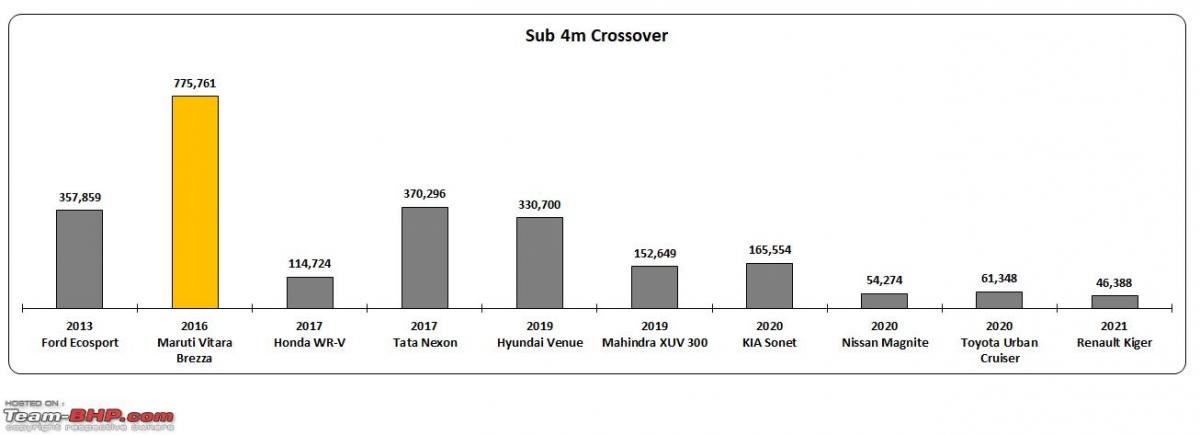
The success rate for approach 2 was very high. Approach 3 has more cost synergy, but is more constrained to delivering the right value.
Sub 4m SUV (Ladder chassis)

Except for ladder frame specialist Mahindra, nobody else tried their luck in this category.
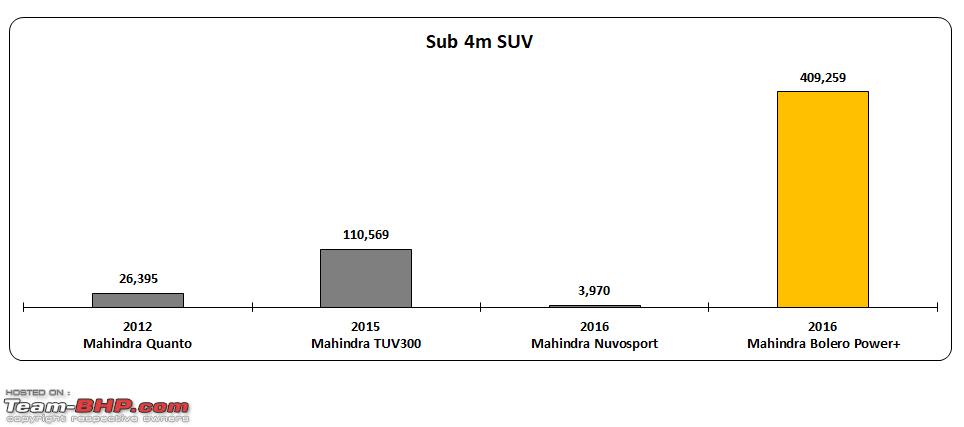
Quanto: In its first attempt, Mahindra simply tried to shrink Xylo and came up with an even uglier product. Failed!
TUV 300: Mahidra developed a new product from the ground up. Failed again!
NuvoSport: Unashamed Mahindra tried to revive Quanto with a new look and a new nameplate. Failed again!
Bolero power+: When nothing else worked, they simply shaved off the front and rear bumpers of the Bolero to fit the 4m length criteria, deployed the 1.5L D70 diesel engine, and got a lower GST benefit. Mission accomplished with old wine in slightly smaller bottle!
Thar: Always has a length of less than four meters but has never qualified for a lower tax bracket due to the engines size
Sub 4m MUV
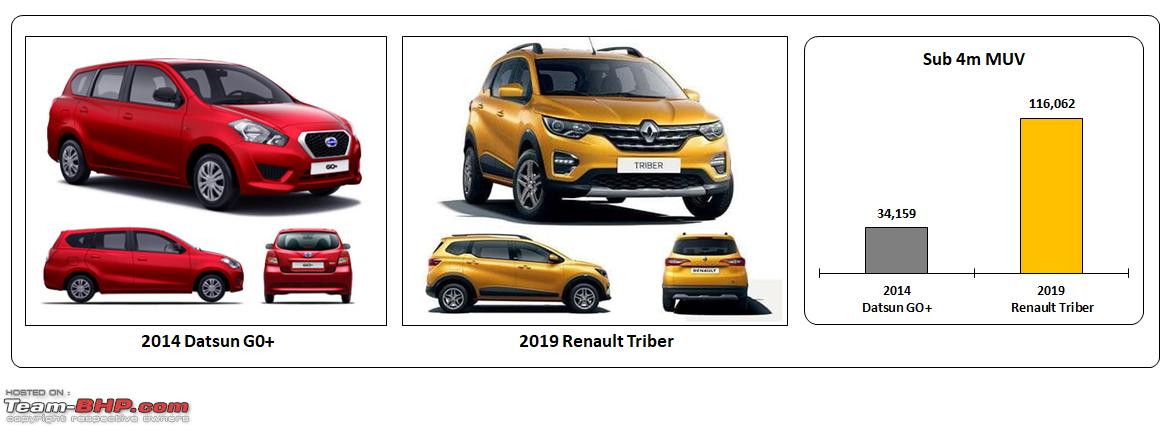
Approach 1: Repurpose existing product
Datsun GO+: Take a cheap Datsun GO, stretch its rear part till it starts looking like a station wagon, and then add third row seats with no leg space. Dreadful recipe, dreadful outcome!
Approach 2: Grounds up development
Renault Triber: Developed from the ground up, with brilliant packaging and a usable third row, and the result is decent. If Renault has added an optional turbo petrol engine (current 1L naturally aspirated petrol engine seems underpowered) and started selling it from Maruti’s dealership network, then it has the potential to cross the 10,000 mark monthly.
Myth around Maruti?
There were always some rumours that Maruti lobbied hard for the small vehicle tax system, and kept nursing the idea. A look at the product launch chronology says otherwise, as Maruti was never the first one to get the advantage.
2012 Dzire (sub 4m): Launched 6 years after policy enactment; Tata (Indigo CS) was the first mover
2015 Baleno: Launched 9 years after policy enactment; Skoda (Fabia) was the first mover
2016 Brezza: Launched almost 10 years after policy enactment and lost the advantage by 2020; Ford (Ecosport) was the first mover
They never developed a purpose-built MUV for family oriented buyers to take advantage of lower tax slab
Body style: Sub 4m category
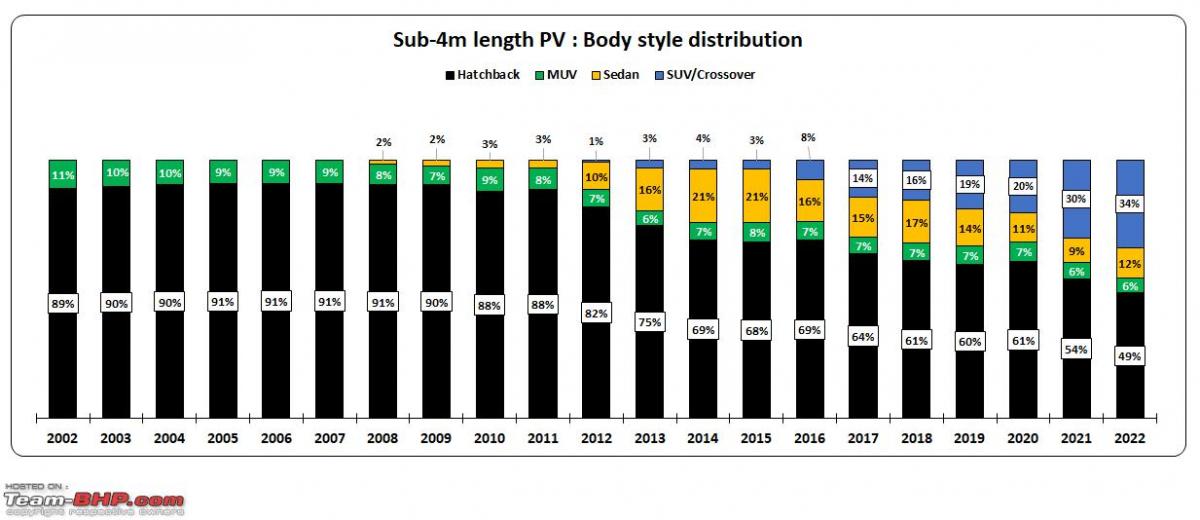
- Sedan products came first and enjoyed a good share in the first half of the last decade
- Later came the crossovers and became the new favourite of Indians
- Crossovers now started challenging the dominance of hatchbacks
- The MUV segment is kept alive by vans from Maruti’s stable – Ecco and the discontinued Omni
Manufacturer in sub 4m category
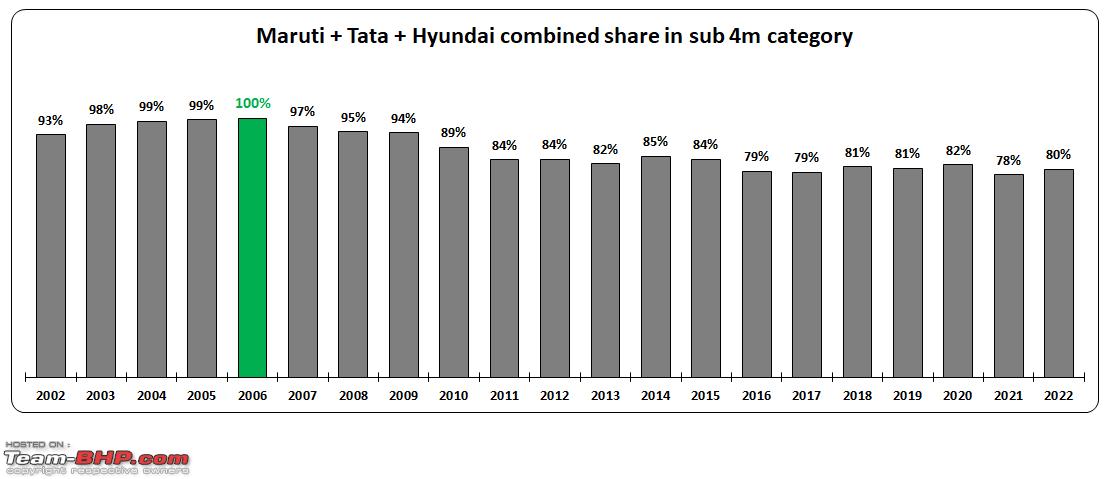
Maruti, Hyundai, and Tata together have dominated the sub-4m segment with nearly 80% market share over the last decade.
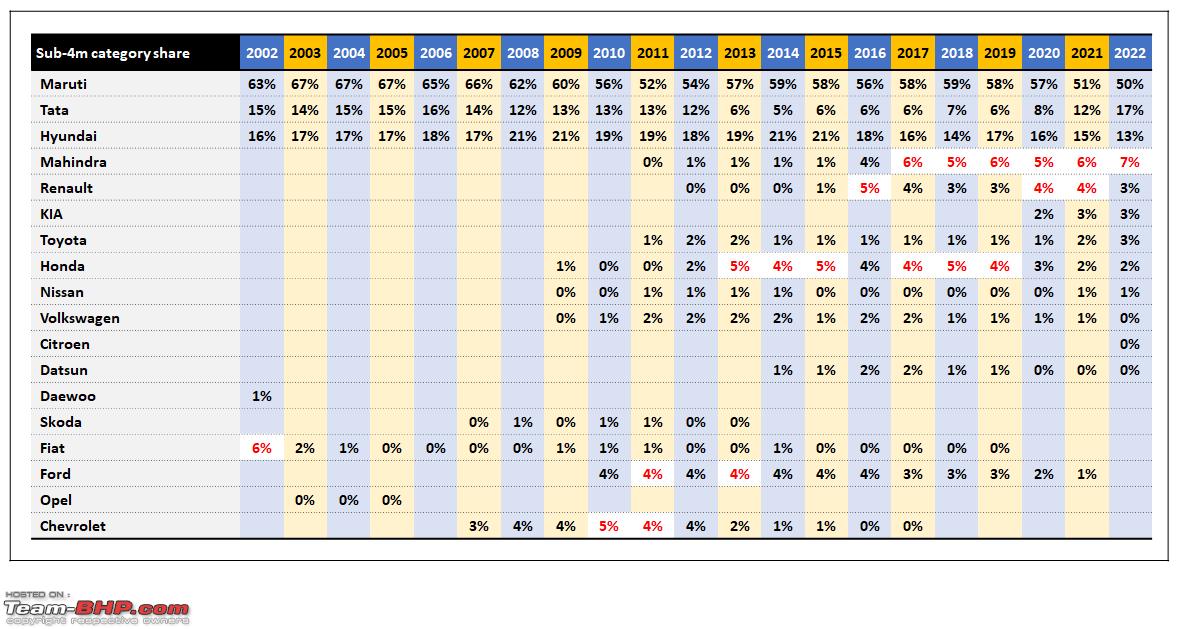
That also means that other manufacturers have little or no space to take a breath. Some of them (Fiat, Ford, and Chevrolet) were very promising in the beginning and gained over 4% share in this tough war, but later could not sustain it and eventually had to exit this space. Mahindra and Honda are still trying hard—will they succeed? Only time will tell.
Fuel preference in sub-4m category

Since its inception, petrol engines have dominated the segment. Manufacturers also tried with small diesel engines (Maruti, Hyundai, Tata and Chevrolet), but success was quite limited. FIAT’s 1.25L diesel was most successful, because Maruti deployed it across many high volume products, Hyundai and KIA comes next.
- 2012-2019: diesel engine demand was shrinking due to the low fuel price differential
- 2020: The discontinuation of Maruti's diesel products in the BS6 era, combined with Ford's demise, reduces the diesel mix to 10%
- 2022: CNG push from Maruti (expansion of CNG filling station network across India) has resulted in a 13% mix
2022 Manufacturer’s portfolio

- Renault’s entire portfolio is composed of India-specific sub-4m products. That has positioned Renault as a budget brand in India
- Nissan’s lone sub-4-meter crossover has brought the brand back from its near grave experience
- Tata’s current portfolio is sub-4-m heavy, which limits its higher average revenue earning potential per car sale
- Maruti tried hard to sell large vehicles but achieved the most success only with the Ertiga
- Mahindra's sub-4-m share is driven largely by Bolero
- The 2nd generation Amaze is doing pretty well for Honda
- Toyota’s entire sub-4m share comes from rebadged Maruti products
- KIA’s sub-4m plunge is limited to Sonet, and the rest of the portfolio is composed of large products
- Volkswagen, Skoda, Jeep, and MG don’t have any sub-4-meter offerings as of now
Graphical representation of the sub-4m journey of manufacturers in the last two decades
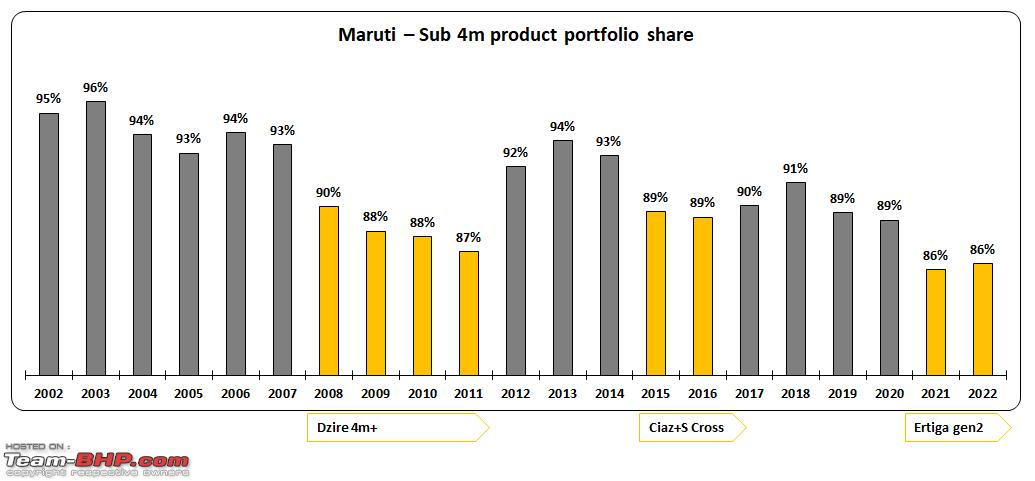
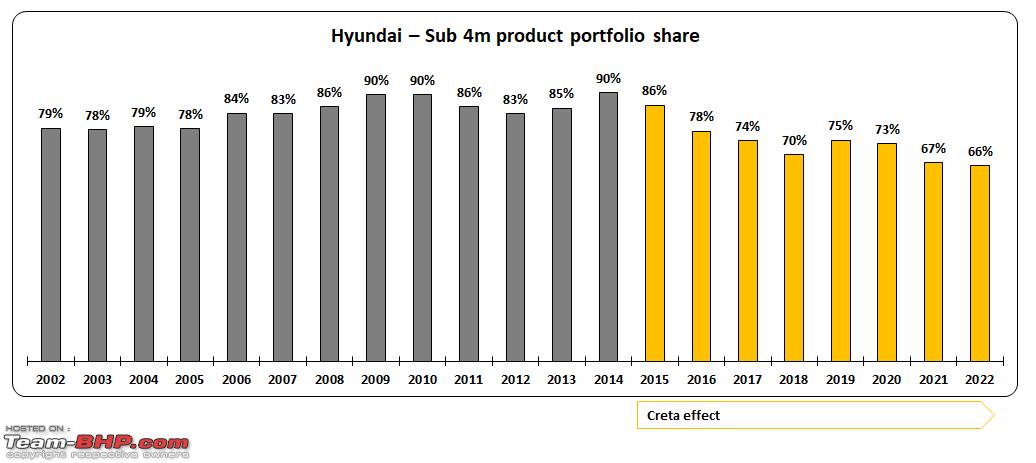
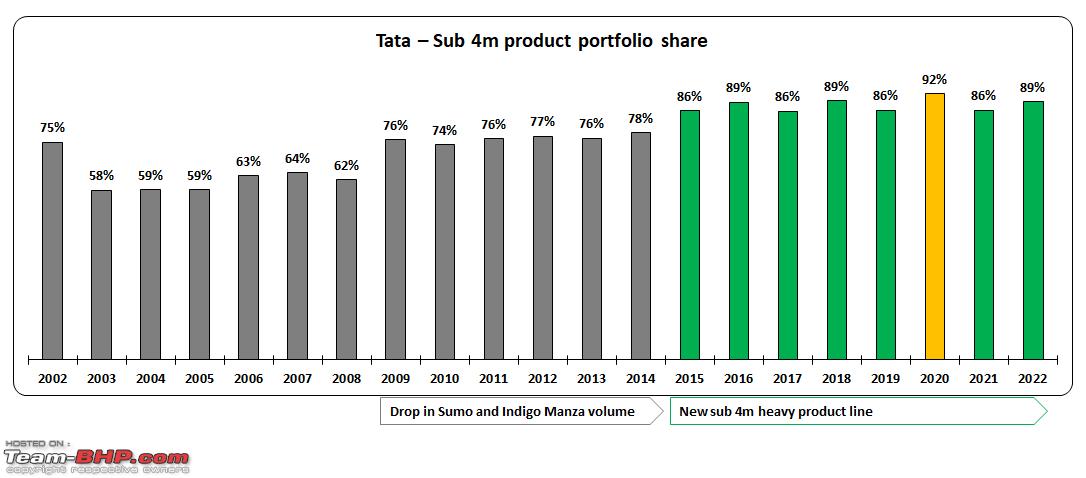
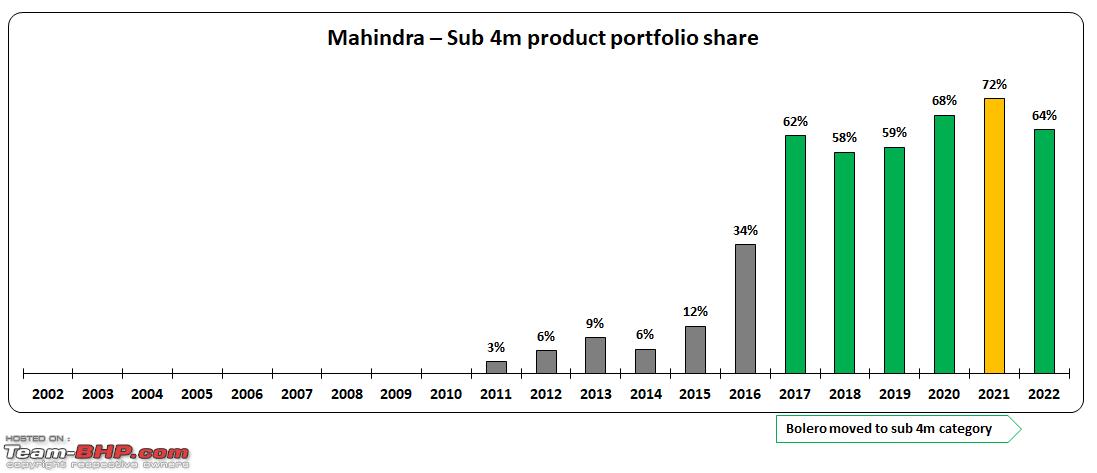
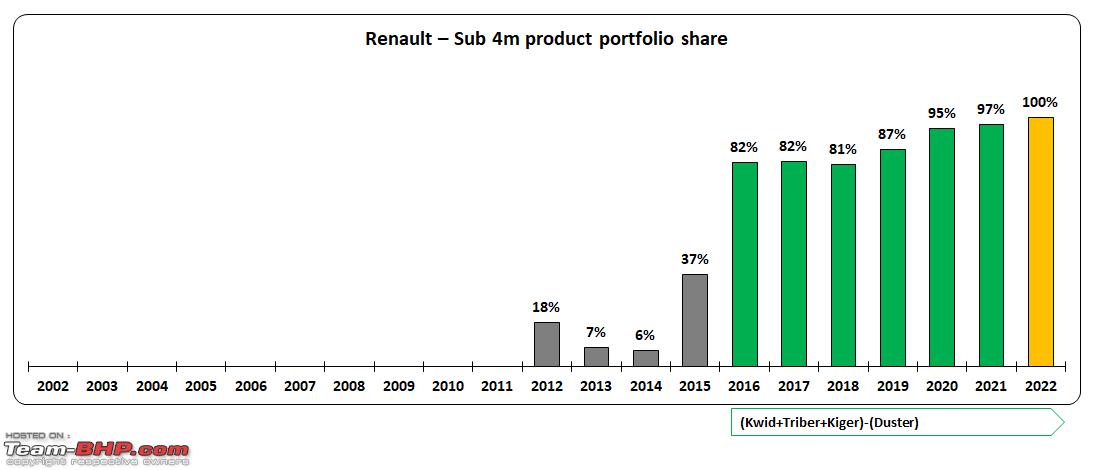
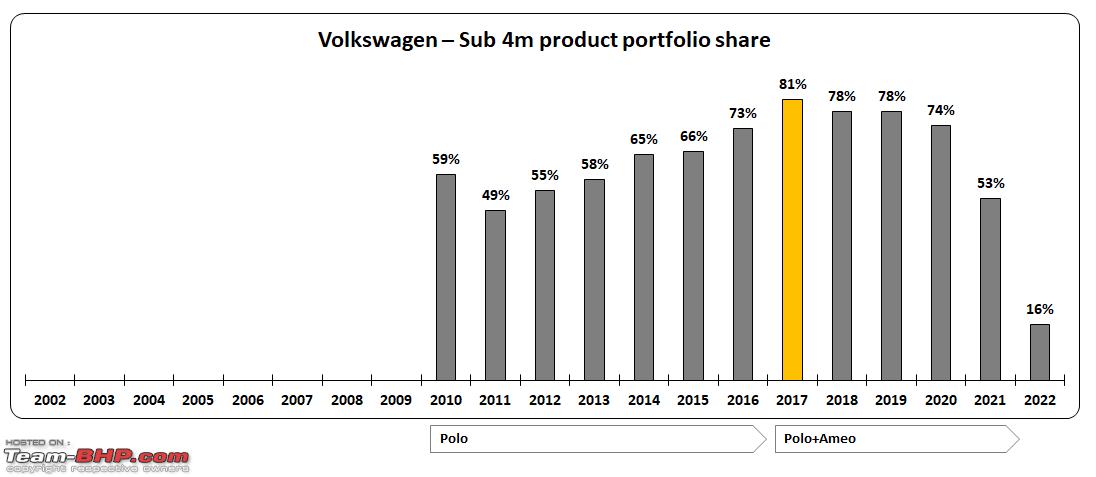
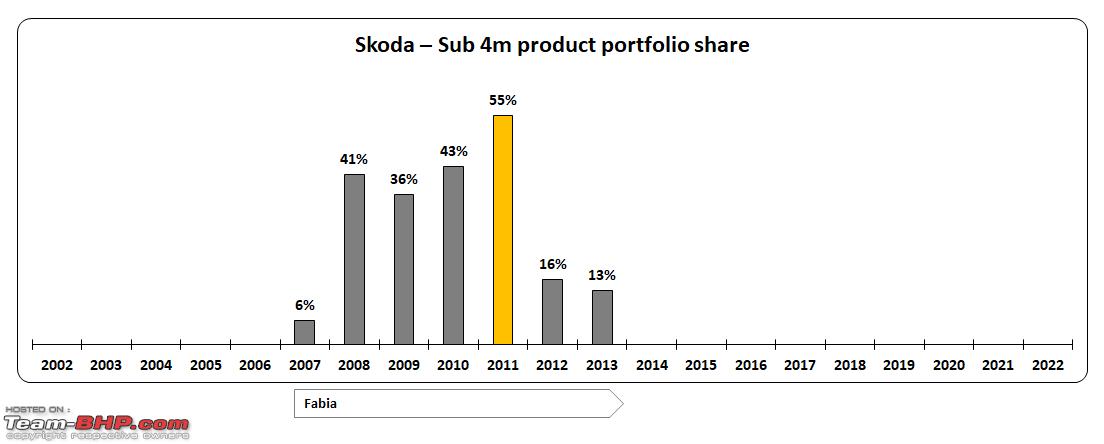
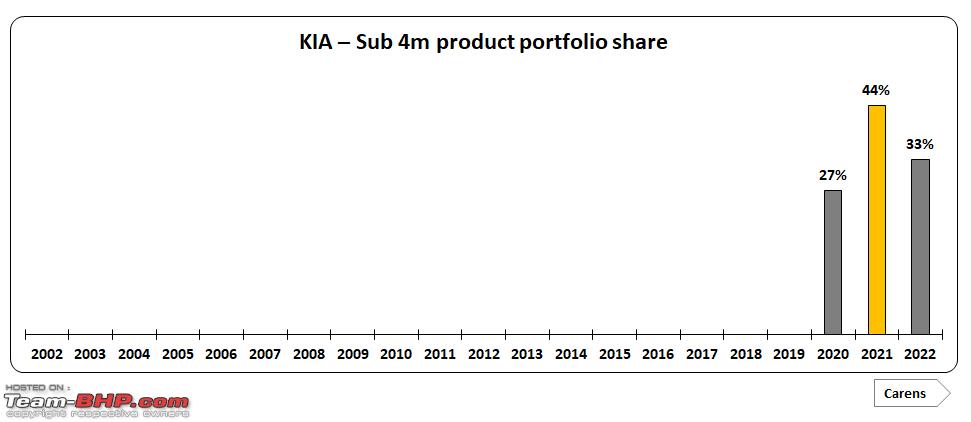
Read BHPian comments for more insights and information.
Pages






